WINTER Exhibition 2022
101 Yeovilians
Winter Exhibition 2022 - presented by Yeovil's Virtual Museum
Introduction
What makes any
town great? -
surely it's the
people who live
and work in it.
This exhibition
features 101
Yeovilians who
made Yeovil what
it is today -
their legacy may
not be obvious
today, but it
remains.
The brief biographies of the 101 Yeovilians here, presented in alphabetical order by surname, are a complete mix of the town's population from the high and mighty to the humblest - the only prerequisite for inclusion here is that I needed to have a back story for each person and a photograph, portrait or sketch of them. Click on any name and it will lead you to that person's page with full details and, often, more photos.
![]()
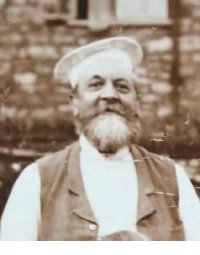 |
William
BANFIELD William Banfield was born in Southleigh, Awliscombe, Devon, in 1840. During the 1850s and into the 1860s, William served in the 1st Battalion, Coldstream Guards, seeing service in the Crimean War (1853-1856). After a brief period in service, On 10 February 1874, at Beddington, Surrey, William married Louisa Maria Kelly (b1838). William and Louisa moved to Yeovil, where their four children were born. |
William started a bakery in Middle Street (certainly by 1875), in premises opposite Bond Street. In 1876 he advertised himself as a 'Cook, Confectioner, Fancy Bread and Biscuit Baker'. By August 1879 William had opened refreshment premises in High Street, opposite the Town Hall, offering wines and market day dinners.
William Banfield died on 28 July 1904, at Gillingham, Dorset. In 1928, William's son, William Frederick, known as Fred, opened the Cottage Café at 16 Hendford. It was later run by William's grandson, Eric Banfield until it was sold in 1972. William's great-grandson, Bob Banfield, ran the adjoining Modelkits until 1993.
![]()
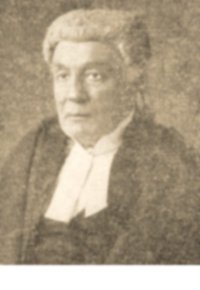 |
Henry Butler BATTEN Henry Butler Batten was born at Aldon House towards the end of 1845. He was the son of John Batten the younger and Grace Eleanor née White of Up Cerne, Dorset. By 1875, Henry was listed as a partner in the family law firm but by 1883 Henry was the sole partner. At this time the family law firm was at Church House, built by the Batten family around 1765. The firm became Batten & Co after Henry's death, as it remains today. |
It was during the 1880s that his father retired from being Yeovil's Town Clerk and Henry became the new Town Clerk - a position he held for over thirty years, finally retiring in the 1912 - the year of his death at the age of 66.
![]()
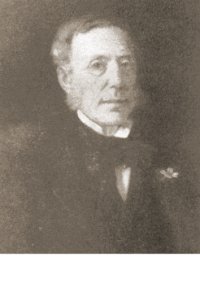 |
John BATTEN the Younger
John Batten the younger was born in Yeovil on 17 February 1815, the eldest son of solicitor John Batten the Elder and Sarah née Copeland. In 1832, he became an articled clerk to his father for a term of five years.
In 1829
Edmund Batten's
nephew John Batten
the
Elder
joined the
Batten, Sparks &
Co. bank
which by this
time was known
as
Yeovil Old
Bank.
After
Edmund
Batten's
death in
1836,
partnership
in the
bank was
John
Batten
Snr,
John
Batten
Jnr and
Henry Butler
Batten.
|
In Yeovil on 21 June 1841 John, now qualified as a solicitor, married Grace Eleanor White, some thirteen years his junior. They were to have seven children. In the 1881 census, John listed his occupation as 'Justice of the Peace Somerset & Dorset, Solicitor'. In the 1891 census, and by now aged 76 and a widower, he listed his occupation as 'Magistrate & Deputy Lieutenant of Somerset'. John Batten the younger died at Weymouth on 8 November 1900, aged 85.
![]()
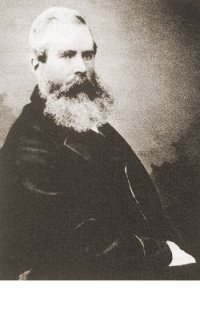 |
William BIDE
the
Younger William Bide the Younger was born in Yeovil in 1809, the second of the six children of William Bide (1780-1829) and his wife, Elizabeth née Mullins (1781-1864). William junior became a prominent glove manufacturer, entering his father's leather dressing and gloving business in Lower Reckleford. William Bide was a Churchwarden at St John's in 1825, 1826 and 1827 with John Highmore and was elected again in 1838 and 1839 with Frederick Greenham. He was also a member of Yeovil's Vestry. |
During 1837 William was one of the founders of the "Yeovil Coal and Potatoe Charity" with the intention of aiding the second poor of Yeovil. Among his other business interests he owned the Charlton Brewery Co Ltd at Shepton Mallet in partnership with Francis Berryman, a brewer and wine and spirit merchant of Wells from 1844. However, William Bide was essentially a glove manufacturer and around 1828 he built the large leather dressing factory with a three-storey leather-dressing warehouse on the corner of Eastland Road and Reckleford, employing over 250 men and women, with more than 2,000 outworkers.
William Bide lived in Kingston House and owned much property in Yeovil, including at least six public houses including the Sun Inn in Grope Lane (today's Wine Street) and the Oxford Inn. He was a co-founder of the Wilts & Dorset Bank and was a Churchwarden at St John’s. In 1846 became an Improvement Commissioner and a Special Commissioner and he topped the poll in the first election for Town Councillors in 1854. He was a prime mover of the Yeovil Improvement Bill and, largely as a result of his efforts, Yeovil's badly-neglected services were upgraded in the town including the provision of public water supply.
He died from tuberculosis on 7 August 1864 at the age of 55.
![]()
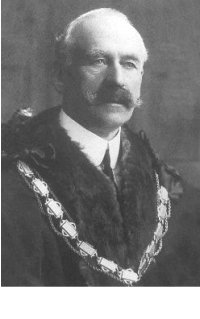 |
John Henry BOLL
John Henry Boll was born Johannes Heinrich Boll in 1858 in Hanover, Germany, to a family of corn merchants and ship owners. He moved to Yeovil in 1878 to become an apprentice of John Hill and became a naturalised British citizen in 1885 and Anglicised his name at the same time. He was employed at Hill's Carriage Works in Park Road and was an agent for various brands of bicycles and tricycles. Hill's Carriage Works was founded by John Hill but run for many years by his widow Sophia, née Milborne. |
John married Sophia's daughter, Bessie Sophia, in 1886 and became a partner in Hill's Carriage Works. By the following year the business had become Hill & Boll, Carriage Builders of Kingston and Park Road. In the late 1890's John entered local politics and was elected to Yeovil Town Council in 1898. He served as mayor from 1911 to 1912. John Boll died in Yeovil in 1916. He was aged 58.
![]()
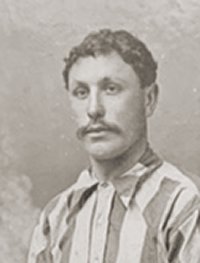 |
Frederick James BOND Frederick James Bond, known as Fred, was born in Ash during the spring of 1873. He was the third of the six children of farmer of Lower Lyde Farm, William Bond (1832-1907) and Mary Ann Hoare née Bishop (1847-1936). Fred was educated at the Kingston School in Yeovil where, no doubt, he gained his first taste of association football, under the guidance of John Aldridge, founder of the school. Fred's father, William, was more of a rugby man and had played for the town side, yet in later life took up football playing for Yeovil, and even playing against his son, Fred, in 1889. |
Association football first came to Yeovil in the 1890/91 season and was played in conjunction with the Yeovil Rugby Club, both playing games at the cricket ground in West Hendford - at the time enjoying the sobriquet 'Cricket Lane'. From an early age, Fred was a very talented footballer, playing against men's teams from the age of fourteen. Positioned as a half back, he was known as a hard working, tough tackler with a terrific and powerful shot.
At just eighteen Fred was the captain of the Yeovil team, remaining Captain until 1904. Fred played for Yeovil for 25 seasons, and his association with Yeovil Football Club lasted long after his playing days. He attended matches as often as possible and was even photographed before the famous Sunderland FA Cup match in 1949. Frederick James Bond died in Yeovil during the spring of 1958. He was aged 85.
![]()
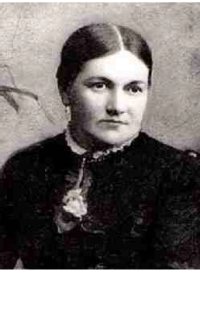 |
Mary
Miriam
BOWDITCH Mary Miriam Bowditch was born on 10 August 1856, at Shadwell, London, and baptised on 24 April 1859 at St Mary's, the parish church of Beaminster, Dorset, aged two years and eight months. She was the eldest of the eight children of shoemaker Daniel Bowditch (1833-1905) of Beaminster and Emily née Newport (1833-1905). In the summer of 1876, Mary had a daughter that she named Alice Priestly Bowditch. The name of the father is unknown. |
On 13 March 1881, at Allington, Dorset, (just north of Bridport), Mary married labourer George Forsey (1852-1894). By the time of the 1891 census, Mary and George had moved to Yeovil where they became the landlord and landlady of the Royal Marine. The census described George as a 'Landlord of a Public House' with Mary described as a landlady. In 1896, during George and Mary's tenancy, the original fabric of the Royal Marine was demolished and the present building was erected. George Forsey died in 1894 and Mary continued as licensee in her own right for a couple of years after his death - it was quite common for a widow to carry on as licensee after the death of her husband. In October 1900, at St John's church, she married widower George Talbot (1845-1921) and he is listed as licensee from then.
George Talbot, last recorded as the landlord of the Royal Marine in 1919, died in 1921 but was probably landlord until his death. Mary, first as Mrs Forsey and later as Mrs Talbot, completed 50 years as landlady of the Royal Marine. She probably relinquished the title of landlady after the death of George and she moved to Brooklyn, Lyde Road. Mary died in Yeovil on 7 May 1936, aged 79.
![]()
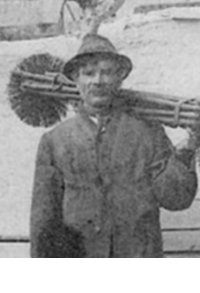 |
John BOWER
John Bower was born in Yeovil in 1868, the eldest child of labourer Charles Bower (1842-1897) and his wife Mary Ann (1837-1935). In the 1870s, the family lived at New Prospect Place which was built between 1814 and 1829. It was also known as 'The Colony' and was a long terrace of very small cottages, essentially slums occupied by the very poorest families. In the summer of 1887 John married Sarah Ann Hann (1867-1939) at Yeovil. John and Sarah were to have eleven children |
In the 1891 census, it appears that John and Sarah were spending some time apart as he was listed as a prisoner in the police station in what is now The Town House in Union Street. John was charged with aggravated assault on a woman named Lucy Street at the White Horse Inn in Brickyard Lane and served six weeks imprisonment. By 1910 John and his family had moved to 7 Edwards Buildings in Higher Kingston and it was around this time that he began to get into frequent trouble with the authorities for keeping his children out of school. Worse, when they did attend school they were found to be dirty and verminous.
During the 1920s, John Bower and his son Charles were working as chimney sweeps based at their home at 103 Park Street. John Bower died at Yeovil in the winter of 1934, aged 70.
![]()
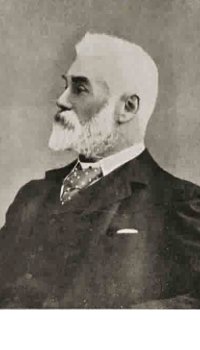 |
Joseph BRUTTON Joseph Brutton was born on 25 May 1831 in Exeter, Devon, and was the son of Joseph Able Brutton (1795-1837), gentleman, and Margaretta née Browne (1797-1874). Joseph senior was in the licensed trade. By 1854 Joseph had moved to Yeovil and entered into business with Thomas Cave who had established a brewery behind his house in Princes Street. The company originally started life as Kitson & Cave, subsequently Cave's and from 1854 as Cave & Brutton. Thomas Cave was a very active Yeovil Freemason and Joseph Brutton is known to have joined Yeovil's Lodge of Brotherly Love on moving to Yeovil. |
In 1860 at Osmington, Dorset, Joseph married Elizabeth Lillington Hall, the daughter of gentlemen Charles Hall and Elizabeth née Lillington. On his marriage certificate Joseph described his rank as gentleman and his residence at the time of marriage as Yeovil. Joseph and Elizabeth were to have four children. In the 1861 census, living in Princes Street, Joseph, now aged 29, described his occupation as 'Brewer, Wine and Spirits Merchant'. Elizabeth died on 18 May 1869 and was buried in Yeovil Cemetery.
In 1870 Joseph was elected by the Vestry as the town's nominated Churchwarden at St John's and was re-elected in 1871, 1872 and 1873. In the 1871 census Joseph was described as a widower aged 39 and gave his occupation as 'Common Brewer, Wine and Spirit Merchant, Master, employing 20 men'. On 24 January 1872 at Buckland Newton, Dorset, Joseph married Mary Georgiana Cull, daughter of gentlemen James Cull of Buckland Newton. Joseph and Mary were to have nine children, mostly born in Yeovil.
Joseph retired due to ill-health in 1893 and moved to Eastbourne, Sussex. He died on 21 February 1914 aged 82.
![]()
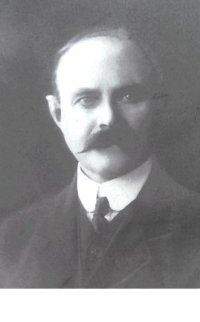 |
Norman BUCHANAN Norman Buchanan was born in 1858 at Uig on the Island of Lewis, in the Outer Hebrides. His name in the local dialect was Tormod Iain Saighdear. He was the eldest child of John Buchannan and Ann née Smith. His father had intended that he should follow an educational career but Norman preferred a career in the drapery trade. He moved to Yeovil in 1880 and in the 1881 census he was listed as a boarder in Middle Street at the home of John Dunlop, a draper also from Scotland. Norman's occupation was described as traveller. |
By the time of the 1891 census, Norman, aged 32 and still unmarried, was living in Wyndham Street with his 22-year old brother Alexander. Norman was described as a travelling draper and Alexander was listed as a travelling draper's assistant.
On 30 December 1891 he married Yeovil-born Emily Rose Denmead. By 1901 Norman and Rose were living at 10 Sherborne Road and Norman was described as a 'credit draper'. Norman was a Freemason and was initiated into Yeovil's Lodge of Brotherly Love on 5 June 1895. He served as Worshipful Master of the Lodge in 1904.
In 1905 he made his first attempts to enter into public affairs and contested for a seat on the Town Council in the east ward but was defeated. A vacancy occurred in the north ward during 1906 and he was elected at a by-election, representing that ward for the rest of his political career. He was chairman of the Allotments Committee from its formation and a member of the Finance, Housing, and Sanitary Committees. He was vice-chairman of the Education Committee and was one of the Town Council's representatives on the Board of Management of the County School and the governing body of the Girls' High School. He was a member of the Burial Committee, an ex-officio governor of Woborn's Almshouse and an Overseer of the Poor. He was also a member of the Board of Guardians for about seven years. He served four consecutive terms as mayor of Yeovil from 1912 to 1916 and when war broke out in 1914 his normal heavy duties increased to a very large extent. He was chairman of all the numerous War Committees that sprang up, campaigned on behalf of refugee Belgians, presided at many different meetings, opened various functions, and so forth.
Sadly he died in office. He was killed falling down the stairs in his home, Osborne House, on New Year's Eve 1915 after attending a civic function, although he didn't die until 17 January 1916. He was 58 years old.
![]()
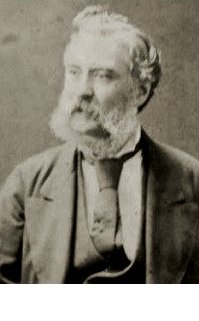 |
John Cox CHAFFIN John Cox Chaffin was born in Yeovil 1826 and baptised in St John's church on 11 October 1826. He was the second son of Kingston baker George Chaffin (b1807) and Ann née Cox (1807-1860). In the 1841 census, living in Kingston, 14-year old John listed his occupation as a draper's apprentice. By 1850, John was a tailor & draper of Kingston. On 10 April 1849 at Holy Trinity church, John married widow Catherine Parker, née Hayward, (c1820-1879). John and Catherine were to have six children. |
In 1862, he established himself as a photographic artist with a studio at 6 Hendford (immediately next door to the Butcher's Arms), which had been the home of his brother George, a builders merchant's clerk. The rest of his family joined the business, and the 1871 census shows the family living at 6 Hendford. John gave his occupation as a photographer, as did sons Thomas and John, by now aged 21 and 17 respectively. Kate and Maria, aged 20 and 19, were both listed as artists. Initially, in 1869, his eldest son Thomas became a partner in the business which was renamed Chaffin & Son. John too became a partner and advertisements began to appear for 'John Chaffin & Sons' (plural), 'Photographers of 6 Hendford' from the Post Office Directory of 1875 onwards.
John Chaffin died in Yeovil on 22 April 1885, aged 59. His children took on the business, which continued until 1919.
![]()
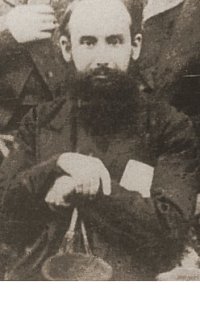 |
Charles CLINKER Charles Clinker was born in 1835 at Alton, Hampshire, the son of William Clinker and Ann née Whiten. During the 1850s Charles married Arabella Leader of Nether Compton and in the 1861 census they were recorded as living in Bradpole, near Dorchester, Dorset. Charles was a reporter on the Bridport News. In 1863 Charles and Arabella moved to Yeovil and Charles founded his own newspaper, 'The Western Gazette'. |
The first issue was bought out on Saturday, 21 February 1863. The main reason for Charles Clinker moving to Yeovil was the recently completed rail links which radiated across the region, thereby facilitating distribution of his newspapers. The weekly newspaper proved extremely popular causing a move to premises in Sherborne Road. Charles went into partnership with Charles Tite, and together they acquired the rival Yeovil newspaper, the century-old Western Flying Post. They combined the two papers under the heading of 'The Western Gazette and Flying Post' on 21 June 1867. In 1870 the paper moved to purpose-built offices on the corner of Lower Middle Street and Newton Road. In 1872 the words 'Flying Post' were dropped and the newspaper became simply 'The Western Gazette'.
Arabella died in the spring of 1869 at the age of 34 and in the spring of 1870 Charles married Sarah Elizabeth Wilson at Tiverton, Devon. In the 1871 census Charles listed his occupation as 'newspaper proprietor and publisher'. On 9 February 1886, Charles Clinker died of a heart attack in a London hotel while on a business trip. He was buried in Yeovil Cemetery. He was aged 51.
![]()
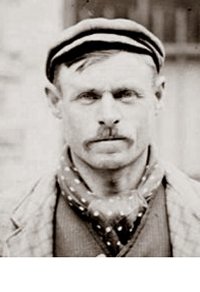 |
John COLLARD John Collard was born in Yeovil in 1866. Sadly, nothing is known of him except the information recorded in the "Swansea and Surrounding Area, Wales, Gaol Records, 1877-1922" following his committal for stealing five sheep skins valued at three shillings (around £18 at today's value). He was committed on 2 May 1899 at Tregaron, Wales, and sentenced to 21 days hard labour in Carmarthen Prison, Wales. He was discharged on 22 May 1899. |
From the Gaol Records, we know that John was a labourer, born in Yeovil in 1866. He had light brown hair and stood 5ft 5¼in tall. His religion was Church of England. Nothing else is known.
![]()
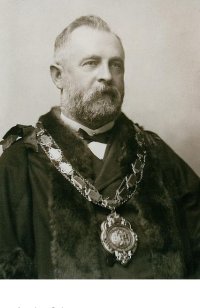 |
Ptolemy COLMER Ptolemy Samuel Henry Colmer was born in South Petherton in 1841, the son of herbalist Robert Slade Colmer and his wife Jane née Allen - who were later both to be found guilty of murder. On 24 February 1865, in St Giles Cripplegate, London, Ptolemy married Susan Jacob. Although they had three children, sadly Susan died in the winter of 1870. In the summer of 1871 however, Ptolemy married his dead wife's sister Frances Louisa Jacob. They had two children, in 1874 and 1878. Sadly Frances died shortly thereafter. |
In 1880 Ptolemy married for the third time at Wood Green, north London. His new wife was Catherine Mary Offin and they were to have two children. In the 1881 census Ptolemy, aged 39, and Catherine, aged 23, were living at South Street House, 79 South Street with six children.
Ptolemy entered local politics and was elected mayor of Yeovil twice, serving from 1887 to 1889 and again from 1890 to 1892. He remained on the council as an alderman after his service as mayor. In 1892 he was appointed as a Borough Magistrate and retired from public office. Ptolemy Colmer died 8 April 1897 in Yeovil.
![]()
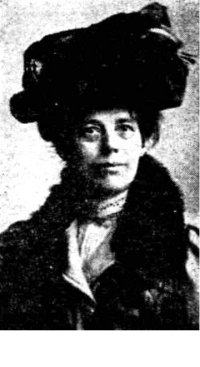 |
Mrs Frances CONNELLY The first female to vote in Yeovil was Mrs Frances Connelly of Reckleford who claimed, and cast her vote, in 1911. In 1918, a coalition government passed the Representation of the People Act 1918, enfranchising women over the age of 30 who met minimum property qualifications. Ten years later, in 1928, the Conservative government passed the Representation of the People (Equal Franchise) Act giving the vote to all women over the age of 21. Mrs Frances Connelly, of Reckleford, Yeovil, discovered that her name was on the register and claimed to vote. |
The presiding officer (Mr WW Henley) demurred. The lady consulted the Conservative agent, Mr Harold Fletcher, who, having in turn discussed the situation with Mr WT Snell, barrister of the Western Circuit, who happened to be assisting in the Committee room, interviewed the presiding officer and represented to him that the lady's name being on the register he had no alternative but to allow her to vote, the only conditions being that she was the person described on the register and had not previously voted in the election.
![]()
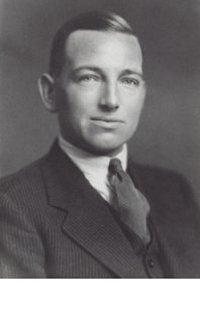 |
Roydon COOPER William Reginald Roydon Cooper, known familiarly as Roydon, Roy or Bill, but known professionally as Roydon Cooper, was born on 25 May 1902 in Shrewsbury, Shropshire. In 1925 Roydon moved to Yeovil to join the Yeovil architectural practice of Petter & Warren at the time the firm was based in Old Sarum House in Princes Street. Roydon Cooper was involved in the design of the Neo-Georgian Municipal Offices in King George Street and also worked on the design for Vincent's car showrooms (now Batten's) in Princes Street. |
In 1930 Roydon Cooper was working in his own architectural practice as "WR Roydon Cooper ARIBA, Chartered Architect, Glenthorne House, Yeovil".
In the winter of 1932 Roydon married Phyllis Olive Mary Jacobs (1905-1976) at Wareham, Dorset. They were to have two sons; William Philip (1933-1980) and David. In the very early 1930s Roydon Cooper designed and built his own house in an Art Deco-inspired, rectilinear modernist style. The house, 76 Combe Street Lane, was called Nobles Nap House which he lived in until his death in 1978.
![]()
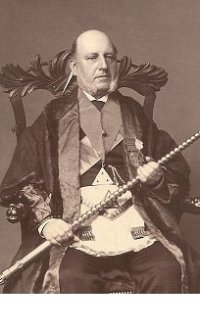 |
Frederick COX Frederick Place connected Middle Street with Vicarage Street for pedestrian traffic and had houses on both its sides until the 1970s. It is now a link from Middle Street to the Quedam shopping centre. Frederick Place was named after Frederick Cox, a local builder, who had a builder's yard there in the latter half of the nineteenth century. Frederick Cox was born in 1825, the son of carpenter, builder and Town Councillor John Cox (1798-1878) and Mary née Hancock (1799-1871). His older brother, William, was to become a jeweller and later Mayor of Yeovil. |
In the 1861 census Frederick was living with his parents in Middle Street and gave his occupation as 'Builder employing 7 men, & 3 boys'. By 1881 Frederick was married, had seven children, two servants and was still living in Middle Street. He listed his occupation as 'Builder employing 25 hands'. Frederick Cox died in Yeovil in 1887, aged 60.
Four local projects built by Frederick Cox were the Medical Hall (1860), Fiveways Hospital (1871), the Congregational Church in Princes Street (1877) and the Corporation Baths in Huish (1885).
![]()
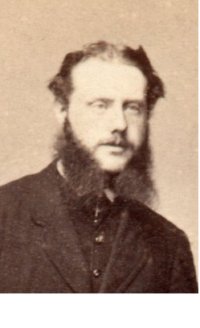 |
Willie DAMPIER-BIDE Thomas William Dampier, known as Willie, was born in 1844. He was the son of wealthy landowner and glove manufacturer Thomas Dampier and his wife Elizabeth (1774-1864), the sister of William Bide. Some time after William Bide died in 1864 Thomas and Elizabeth Dampier moved into his house, Kingston Manor House, with their family. Thomas died in 1876 and his wife Elizabeth died in 1881 after which their elder daughter Elizabeth, known as Bessie, and Willie their only son lived there for the rest of their lives and neither married. |
They inherited considerable property from William Bide and Willie added Bide to his surname by Royal License under the terms of William Bide's will. In the 1880s, after the death of their parents, Willie and Bessie travelled extensively in Europe undertaking long voyages including a five-month tour of Egypt and the eastern Mediterranean in 1882 and then a two-year tour of India, Australasia, the Far East and North America from November 1886 to December 1888.
Willie took little part in Yeovil's public affairs, although he did subscribe generously to local charities and to St John's church. He was a Justice of the Peace for Dorset. In their later lives Willie and Bessie lived quietly and comfortably at Kingston Manor House, occasionally visiting London where they stayed at the Metropole Hotel in Northumberland Avenue. Bessie died in 1915. On his death in 1916, Willie bequeathed a large part of the grounds of Kingston Manor House, lying between Court Ash, Court Ash Terrace and Red Lion Lane, known thereafter as Bide’s Gardens, to the town.
![]()
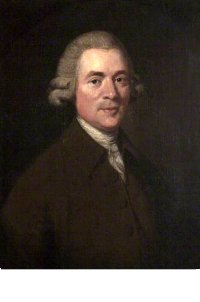 |
John DANIELL the Elder John Daniell, also known as the elder, was born in Yeovil around 1725, the son of Yeovil mercer and linen draper Samuel Daniell the Younger and his wife Hannah. In February 1747 he married Elizabeth Goodford, the daughter of Samuel Goodford a prosperous glover. His fortune steadily grew and in 1776 he built, as his home, Hendford House (today's Manor Hotel) with its extensive grounds. |
Initially a linen draper and mercer like his father, John became a country merchant banker and later went into partnership with a Mr Hoskins. When this partnership was dissolved he became a partner in the bank of Hutchins and Gollup. The bank was taken over in 1819 by Batten, Sparks & Co and, under Edmund Batten, became known as Yeovil Old Bank in premises next door to John Daniell's former home. John Daniell the elder died in Yeovil in 1797.
![]()
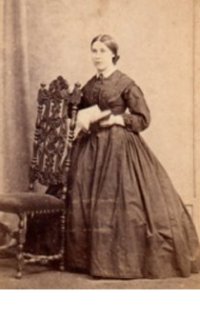 |
Susan ELLIS This is a carte de visite by George Bartlett Coggan and depicts Susan Ellis (1839-1903) originally from Halstock, Dorset, who, in the 1861 census (about the time of this photograph) was listed as a 23-year old servant living with and working for the family of bookseller, stationer and printer Henry Wippell at (today's) 1 & 3 Princes Street. At Halstock on 15 June 1862, Susan married soldier George Paul, eight years her senior and also from Halstock, where they lived after their marriage. |
They had at least one son, Walter, born in Halstock in 1863 before the family moved to Leeds, Yorkshire. They returned to live in Halstock by 1901. Susan died at Halstock in 1902, aged 73, and George died there in 1903 aged 82.
![]()
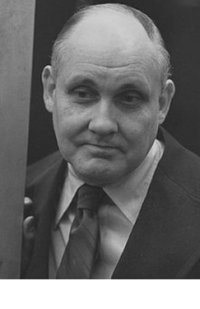 |
William Keith EVERSON William Keith "Bill" Everson was born in Yeovil on 8 April 1929, the son of aircraft Engineer Percival Wilfred Everson and Catherine née Ward. Bill Everson became a renowned film archivist, author, critic, educator, collector and film historian, often discovering lost films. Emigrating to the United States in 1950 at age 21, he worked in the publicity department of Monogram Pictures (later Allied Artists) and subsequently became a freelance publicist. |
Everson became dedicated to preserving films from the silent era to the 1940s which otherwise would have been lost. Through his industry connections, he began to acquire feature films and short subjects that were destined to be destroyed or abandoned. Everson was an influential figure to the generation of film historians who came of age from the 1960s to the 1980s.
Bill Everson died on 14 April 1996, at the age of 67, in Manhattan, New York. He was survived by his wife, Karen Latham Everson and two children.
![]()
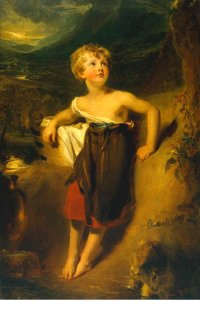 |
Lady Georgiana FANE In 1800, John Fane, 10th Earl of Westmorland, took as his second wife Jane Saunders, a lady so wildly eccentric that she was described as ".... perhaps not mad, but nobody ever approached so near it with so much reason". The Countess
decided to shock
conventional
society and
leave her
husband, taking
their first
child (his fifth
daughter) Lady
Cicely Jane
Georgiana Fane,
known as Lady
Georgiana, with
her. This
unconventional
pair of ladies
set up home at
the
family
seat, Brympton
d'Evercy. Lady
Georgiana
Fane
inherited
the
estate,
together
with
half of
Prince
Edward
Island
in
Canada. |
Lady Georgiana, like her mother, was apparently of a 'lively' disposition but her chief claim to fame was her relationship with Arthur Wellesley (1769-1852), the 1st Duke of Wellington. Lady Georgiana first met Wellington just after the Battle of Waterloo in 1815, when she danced with him at a ball in Paris - she was aged 14, he was 46. In her twenties, she became "friendly" with Lord Palmerston, who apparently proposed marriage to her. However she declined Palmerston and instead turned her attention once again to Wellington. During her twenties their relationship turned into a romance lasting over twenty years, although Wellington was married.
Wellington's wife, Kitty Pakenham, died in 1830. By this time Lady Georgiana was 29 and Wellington was 61. But now she found that she had to compete with a plethora of high ranking ladies, both married and unmarried, who were keen to secure the eligible widower for themselves. Possibly because he felt uncomfortable about the increasingly persistent tone of her letters to him, Wellington decided to break off his relationship with Lady Georgiana. However, when he ended the relationship she tried to sue the Duke for breach of promise. Lady Georgiana's mother, the Countess, died 26 March 1857 and Lady Georgiana lived on as the sole chatelaine of Brympton. She never married and died on 4 December 1874.
![]()
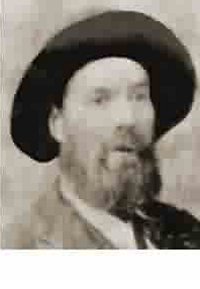 |
William FARLEY William Farley was baptised in St John's church on 19 March 1815 but he was probably a couple of years old at the time since he was aged 16 in 1829 when he served a month in the County Gaol at Ilchester and received a whipping "Charged on his own confession of stealing a quantity of Skins of Benedict Edward." He
was held
in
Ilchester
Gaol
from 4
April
1829 and
released
"By
Expiration
of
sentence
27 May
1829". |
The Gaol's Description Book recorded a physical description of William Farley which reads - age 16, height 5' 1½", build Slight, complexion Fair, face Long, hair Sandy, eyes L(ight) hazle, large cut on the right leg, Born Yeovil, Occupation Leather Dresser, Place of abode Yeovil, Marital status Single.
Within a couple of months of his release William was in trouble again for stealing a sheep, with an accomplice William Trenchard. They were both sent to Dorchester Gaol on 19 September 1829 to await trial at the Dorchester Assizes (the offence having taken place in Dorset). At this time 16-year old William gave his occupation as a brick maker. On 12 March 1830 both William Farley and William Trenchard were tried at Dorchester, found guilty and sentenced to death, later commuted to transportation for life. They moved from Dorchester on 3 May 1830 to board HMS Burrell. They sailed from Plymouth en route to New South Wales, Australia, arriving in Sydney Cove after a long and arduous sea journey. On arrival William was imprisoned in Berrima Gaol. He was later indentured to surveyor and explorer Captain Charles Tyers and worked as a cart driver for Tyers as he surveyed Gippsland (a region in southeastern Australia, extending from Melbourne's eastern suburbs to the New South Wales border). After seventeen years William received a conditional pardon on 19 February 1847 - the condition being that he remain in Australia for the rest of his life and not return to England.
On 6 January 1852 William married Mary Ann Maxella or McSellez (1836-1904). They had ten children although William later deserted them. William Farley died on 28 August 1875 at Gippsland.
![]()
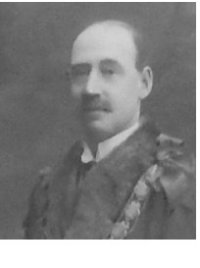 |
Johnny FARR Ernest John Brook Farr , known as Johnny, was born in 1877 in Yeovil, the second son and fourth child of the six children of marine store dealer Joseph Farr (1843-1901) and Elizabeth née Belben (b 1843). In
1903 at
Weymouth,
Dorset,
26-year-old
Johnny
married
23-year-old
Minnie
Ethel
Amy
Horsey
(1880-1961),
originally
from
Bournemouth,
Hampshire.
They
were to
have
three
children. |
As a young man, Johnny joined the army and served in the South African War, and on leaving the army, he became a Reservist. At the outbreak of war in 1914, as a Reservist, he was called up and was sent to France where he served with the rank of Sergeant. During August 1915, he was wounded in action, and discharged from the army because of his wounds.
He was prominent in the town's affairs and served on the council for many years. He was elected mayor of Yeovil and served during 1921 and 1922. In 1923 the Yeovil & Petters United Football Club became Yeovil Football and Athletic Club Limited, and Johnny was appointed the first Chairman of the Limited Company. Ernest John Brook Farr died in Yeovil on 11 March 1946. The company, EJ Farr & Co, today trades at Buckland Road.
![]()
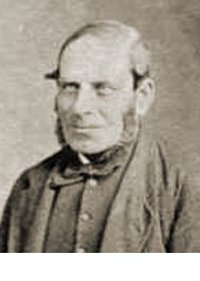 |
Frederick FOAN Frederick Foan was born in Yeovil at 5am on 18 December 1832 and baptised on 21 December 1832 at St John's church, the youngest son of glove manufacturer and grocer Charles Fone (1788-1859) and Mary née Flambert (1792-1853), both of Yeovil.
Charles
owned
the large
Regency-styled
residence built
in London Road
called
Penfield House
(today known as
Osborne House)
and it was
almost certainly here
that Frederick
was born.
|
Frederick's mother, Mary, died in Yeovil in 1853 and his father, Charles, died in Yeovil on 15 March 1859. On 7 June 1859 Frederick married Mary Hodder (1835-1889) at Marshwood, Dorset. Frederick and Mary were to have ten children.
His father's glove manufacturing business was in Middle Street and it seems likely that Frederick took the business over. He is listed in the 1861 census in Middle Street with Mary and baby son Alfred and a 12-year old nursemaid. Frederick gave his occupation as a 'Leather Glover Employing 2 men & 1 boy'. Frederick Foan died at 4.30pm on 20 November 1903 at Dover, Kent. He was aged 70.
![]()
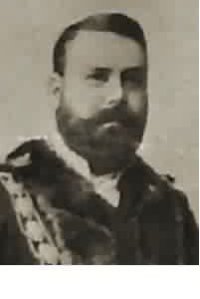 |
George Wrentmore GAWLER George Wrentmore Gawler was born in Yeovil in the summer of 1850. He was the son of glove manufacturer Charles Dycear Gawler (1819-1903) and Louisa née Maxwell (c1820-1897). In the winter of 1872, at Shepton Mallet, George married Jane Grimes (1842-1907). They were to have three children. In
the 1881
census
George
and his
family,
together
with two
servants,
were
living
in what
had been
his
grandparent's
house at
7
Wyndham
Street,
and his
parents
were at
5
Wyndham
Street,
with
their
glove
factory
between
them. |
30-year old George gave his occupation as a glover. It was around this time that George became involved in the local political life of Yeovil. Around 1890 his father retired, and the glove manufacturing business was taken over by George. By the time of the 1891 census, George had moved his family into what had been his parent's house at 5 Wyndham Street. George now gave his occupation as a glove manufacturer. At this time George not only served on the Borough Council, but also on the Somerset County Council. In 1892, George was elected mayor of Yeovil. He was to serve for just one year.
Following his year as mayor, George spent some time in Africa. He moved to London on his return, and it appears that around October 1894 George deserted his wife and three children for one of their servants. In October 1895 Jane sued for maintenance, claiming that George had paid nothing for over a year. The judge found for Jane and ordered George to pay her £2 a week. George "presented himself at the Yeovil Union on Thursday morning [3 October 1895, immediately after the hearing], and became an inmate of the infirmary wards." Jane died in Yeovil in the winter of 1907, aged 65. George subsequently emigrated to Gloversville, USA. He died there on 31 December 1916. He was aged 66.
![]()
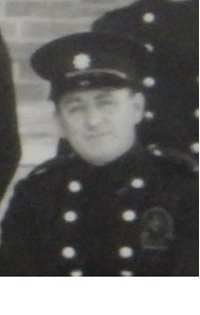 |
Charlie GILLARD Charles Henry Gillard, known as Charlie, was born in Yeovil in 1903, the son of Charles Gillard (1866-1912) and Elizabeth Ann née Smith (1869-1948). In 1923, at the age of 23, Charlie married Ada Sutton in Yeovil and they set up home at 134 Hill Crest Road. They were to have one son, Dennis. During the 1920s Charlie started work at the Yeovil & District Co-operative Society's bakery, which was located behind the Co-op's first branch outlet in Orchard Street. Charlie was to work at the bakery for the next fourteen years. |
Before the start of the Second World War Charlie joined the Auxiliary Fire Service (AFS) when it was first formed in 1938 and he was to serve for the next three years. On Good Friday, 11 April 1941, late in the evening, several incendiary bombs and delay-action bombs hit Yeovil town centre in the sixth German air raid on the town with one destroying the Medical Hall in the Borough and another killing four soldiers billeted in the Corn Exchange behind the municipal offices in King George Street. The Corn Exchange was nearly completely destroyed but a fire was raging in the ruins. While fighting the fire in the Corn Exchange, Auxiliary Fire Service Patrol Officer Charlie Gillard was killed when the delay-action bomb exploded in the early hours of 12 April. Charlie was 37 years old.
![]()
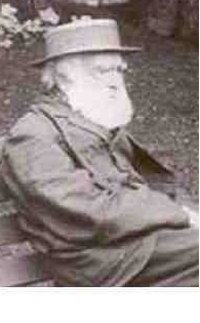 |
Alfred GILLET
Alfred Gillett was born in Langport on 24 February 1814, the eldest of the eleven children of Quaker shopkeeper and chemist John Gillett (b1786) and his wife Martha. By 1843, Alfred
had moved to
Yeovil and entered
a
partnership with
a distant
relative, the
established
ironmonger
Josiah Hannam,
a prominent
Quaker.
The business
in the
Borough, was known as
Hannam & Gillett
from that time.
The
partnership was
dissolved, and
in 1865 the
business was
bought
by
John Petter
of Barnstaple,
Devon, who gave
it to his son
James Bazeley
Petter as a
wedding
present |
After retirement, Alfred moved to Street in 1870s where he was able to pursue his passion for palaeontology, taking advantage of the early nineteenth-century expansion in quarrying that had developed around the village. He amassed a fine collection of Street Ichthyosaurs, including eighteen near-complete Ichthyosaurs, a Plesiosaur and over 180 smaller specimens. His collection rivaled the major collections at the Natural History Museum and the Universities of Oxford and Cambridge. Alfred Gillett died on 24 January 1904 at Overleigh, Street. He was aged 89 years and 11 months.
![]()
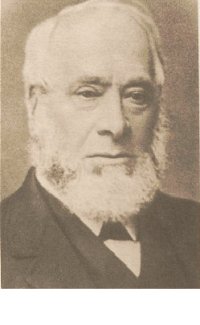 |
Frederick GREENHAM Frederick Greenham was born in Yeovil on 9 August 1802 the son of wealthy glove manufacturer John Greenham (see next) and his wife Elizabeth née Parsons.
Pigot's
Directory of
1824 listed the
company of
Greenham &
Edwards as Glove
Manufacturers of
Vicarage Street,
and Pigot's
Directory of
1830 listed the
company as
Greenham, Sons &
Edwards,
indicating that
Frederick and
his brother
Charles had
joined their
father's glove
manufacturing
business. |
On 25 June 1840 Frederick married Mary Ann Neal, nine years his junior, at Trinity church, St Marylebone, London. Frederick and Mary, the daughter of rope manufacturer John Neal, were to have two sons and six daughters. In 1841 Frederick, described as 'a gentleman', was appointed as an Improvement Commissioner for Yeovil in the place of his late father. The Improvement Commissioners were established by Act of Parliament in 1830 and played a key role in the early development of Yeovil. He was a Churchwarden at St John's in 1838 and 1839. In 1845 he was Custos of the Woborn Almshouse and was also a committee member of the new Huish School. He was Warden of the Woborn Almshouse from 1846 until 1850, a post he held again in 1871.
Frederick Greenham, of Hendford House (today's manor Hotel), was elected to be one of the first Town Councillors in 1854, polling 107 votes. He was made an Alderman and was elected as Yeovil's second Mayor from 1855 to 1856. Around this time the Lord Chancellor appointed him, along with William Bide and John Ryall Mayo, as Magistrates for the Borough. Frederick Greenham died on 4 April 1877 in Yeovil. He was aged 75.
![]()
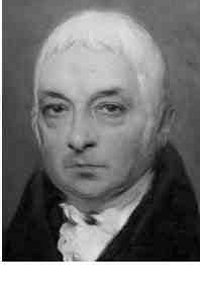 |
John GREENHAM John Greenham was born 7 February 1769 in Somerset, the son of Joseph Greenham (1735-1817) and his wife Grace (b1735) of Chiselborough. John was baptised on 5 May 1768 at Chiselborough.
On 29
May
1795,
John
married,
by
license,
Elizabeth
Parsons
(1768-1860),
the
daughter
of the
Rev
Francis
Crane
Parsons
(1730-1798)
and his
wife
Jane née
Evered
(1739-1822).
John and
Elizabeth
were to
have ten
Yeovil-born
children. |
The Universal British Directory of 1790 listed him as a 'Glover, Lamb & Kid Leather Dresser' of Yeovil. John Greenham was a Yeovil burgess and elected Portreeve in 1797 and Custos of Woborn Almshouse on five occasions between 1796 and 1834 as well as Warden for five terms between 1797 and 1838. He was a member of the Vestry between 1813 and 1837, and was Churchwarden at St John's in 1794, 1795 and 1796. He was an original Improvement Commissioner for Yeovil, elected in 1838 as was his son Frederick (see above) who was elected in 1841. The Improvement Commissioners were established by Act of Parliament in 1830 and played a key role in the early development of Yeovil. John Greenham died on 29 December 1838, in Yeovil, aged 70. Elizabeth, died 5 May 1860 aged 91.
![]()
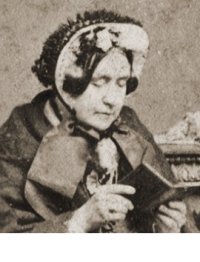 |
Elizabeth GREGORY
Elizabeth
Gregory
was born
in 1817
at
Charlton
Horethorne,
ten
miles
northeast
of
Yeovil,
the
daughter
of
labourer
John
Gregory.
She
married
bricklayer Henry
Sugg,
son of
labourer
William
Sugg, on
29 July
1838 at
South
Street
Chapel,
Yeovil.
On her
marriage
certificate
she was
noted as
a glover
living
in
Reckleford
and
Henry as
a mason.
Neither
she nor
Henry
could
write
and both
made
their
mark on
the
certificate. |
Henry died in the autumn of 1867 and by the time of the 1871 census Elizabeth had become the licensee of the Black Horse. The census lists her as a 55-year old widow and innkeeper of the Black Horse Inn. With her was daughter Lizzie. Elizabeth died at Cricklade in the spring of 1892 aged about 75.
![]()
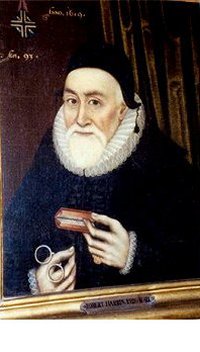 |
Robert HARBIN Robert Harbin began life as a merchant at Blandford and, from the date painted on his portrait, it appears that he was born in 1526. During his residence at Blandford he married Margaret, daughter of Peter Maunsell, and they had seven children. After Margaret's death, Robert married Margaret Mervin, daughter of Sir John Mervin of Fonthill, Wiltshire, and the widow of William Drewry. A prosperous and wealthy mercer, Robert began acquiring a number of small properties in Dorset and Somerset. His final purchase was in 1608 when, at the age of 82, he purchased Newton Surmaville from Joseph Compton. |
He and his eldest son, John, immediately pulled down the old house of the Compton family and commissioned the building of a new grand house at Newton, which was completed around 1612. Robert and his son John moved into Harbin Castle, later called Newton Surmaville House.
Robert Harbin died in Yeovil on 24 December 1621, aged 95. On 10 January 1622 he was interred in the Harbin vault beneath the family pew in the north transept of St John's church.
![]()
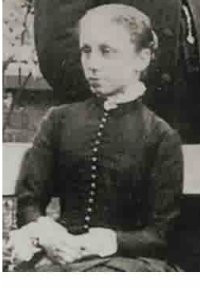 |
Louisa Charlotte HARRIS Louisa was the eldest daughter of George and Charlotte Harris and was born in Yeovil (almost certainly at home at Victoria Place, later No 2 Clarence Street) in 1862 and baptised on 19 October 1862. A lifelong spinster, Louisa was confined to a wheelchair throughout her life which tended to limit her activities although her diaries reveal that she had a surprising number of excursions - either being pushed in her wheelchair (even reaching the summit of Wyndham Hill), being driven in horse-drawn carriages or by railway. |
Louisa kept a journal from 1886 until 1926 and it is important as a record of life in Yeovil during this time. I have included throughout this website snippets from Louisa's journal in highlighted boxes - click on Louisa's name above to explore her diary extracts. Louisa died in 1955 aged 93.
![]()
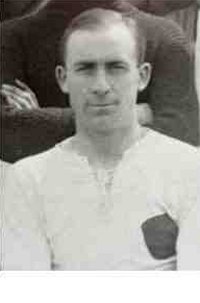 |
Fred 'Johnny' HAYWARD Fred Hayward, known as Johnny, was born in Yeovil in the spring of 1887. He was the youngest of the seven children of glove cutter William Henry Hayward (b1852) and his glove machinist wife Mary Ann née Tutchings (b1853). Johnny's passion was football and from April 1907 he played for his local team, Yeovil Town Football Club. Johnny played for the club until 1927, usually positioned as centre forward and for many years captaining the team. His last match was on 7 May 1927 and he scored seven goals! |
Johnny Hayward holds the record for being the highest goal scorer for a single club in the history of English football. During his career he achieved an extraordinary number of goals - at least 548 (some data on matches in those days was incomplete) and claims a record that will surely never be beaten. At his peak, he netted 52 goals in just 33 games during the 1919-20 season and 50 more in the 1921-22 season. Fred 'Johnny' Hayward retired from football in 1927 and died in 1958, aged 71.
![]()
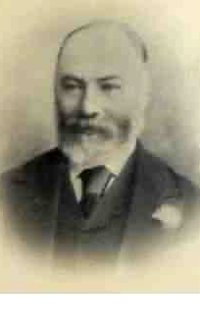 |
Edwin HELLIAR Edwin Helliar was born in South Petherton in very early 1834, the son of William Helliar. By 1861 Edwin was living in Yeovil and working as an assistant to chemist John Alexander of Hendford, in the run of buildings opposite the Three Choughs. He had been working as a 'Manufacturing Chemist' in his own right since 1857 when, at the age of 23 he developed "Helliar's Celebrated Fly, Tick and Lear Powder" for dressing sheep and lambs as an alternative to dipping. |
On 19 November 1864, at Chilcombe, Dorset, Edwin married Elizabeth Cousins (1834-1916). They were to have three children. It was during the 1870s that Edwin became involved in local politics and he was elected to serve on the Town Council in November 1874. In the 1881 census Edwin gave his occupation as 'Chemist & Councillor of Borough of Yeovil'. He was to serve as Mayor of Yeovil from 1884 until 1886 and retired from the Council in November 1889. In 1888 he was made a Borough Magistrate.
He was also a long time member of the Yeovil Agricultural Society and a member of its Committee as well as supporting the Yeovil and County Poultry Show. He also served on the board of the Yeovil & Sherborne Building Society from 1877 until his death on Monday 21 May 1894 at his home in Yeovil.
![]()
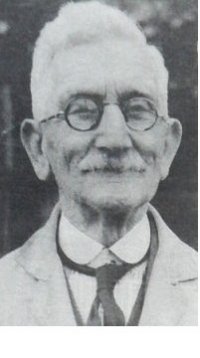 |
Herbert
Edwin
'Herbie'
HIGDON Herbert Edwin Higdon, known as Herbie, was born in Yeovil in the autumn of 1869 most likely at the Smithy in Tabernacle Lane where his father John George Higdon (1846-1875) lived and worked as a blacksmith. In 1881, 11-year old Herbert was employed as an errand boy in a glove factory. The following year 1882, allegedly at the age of 14 but actually barely 13, Herbert signed an apprenticeship indenture with James Bazeley Petter to learn the trade of a blacksmith and brightsmith (that is, a silversmith). In the winter of 1898 Herbie married Ada Louisa Pickard in her home town of Weymouth, Dorset, and they set up home at 32 Middle Street (below the Triangle). |
By this time, Herbie had started his own ironmongery business. In the 1901 census, Herbie listed himself as an employer and gave his occupation as 'Ironmonger, Engineer & Shopkeeper'. He was a keen sportsman and cyclist and was a pioneer of cycling in Yeovil and was known to have ridden a penny-farthing. However, he was the first to bring the the safety bicycle to the town and he is also credited with the introduction of the first machine with pneumatic tires. He also maintained an interest in local politics, being elected to the town council and eventually being appointed an alderman. Herbie Higdon died in Yeovil on 30 March 1956, aged 87.
![]()
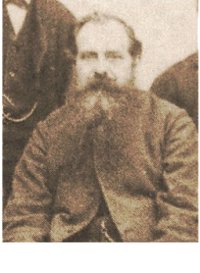 |
Robert Henry HIGHAM Robert Henry Higham was born about 1841 in Constantine, Cornwall, the son of shoemaker Robert Charles Higham (1806-1870) and his wife Elizabeth née Rickard (1809-1890). In the spring of 1853 Robert married Sarah Vivian Goldsworthy of Camborne at Redruth, Cornwall. Sarah died in 1867 and in 1870, at the age of 40, Robert married Louisa Wright, aged 20, at Reading, Berkshire. In the 1871 census Robert gave his occupation as National School Master. |
On 14 October 1875 Robert was appointed headmaster of Reckleford Board School, Yeovil, at a salary of "£170 for the first year, not including gas and coal." In 1891 Robert dismissed a teacher called Hemmings for inefficiency. In turn Hemmings accused Higham of manipulating the school registers in order to earn a larger Government Grant and hence his increase own salary. A full enquiry was held by the School Board which resulted in a reduction of £23 12s in the Grant due to poorly kept registers and Higham was forced to make up the difference from his own salary. In his defence he admitted that he had spent too much time on 'higher subjects', leaving the registers to his assistants and although the Board believed that blame should not be attached to him, he resigned within the year and left Yeovil. Robert Higham died 21 October 1906 at Thornton Heath, Surrey.
![]()
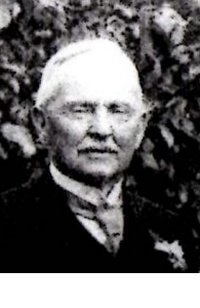 |
Harry
Albert
Simmons
HILL Harry Albert Simmons Hill was born in Sherborne in 1865, the son of coach maker James F Hill (1838-1910) and his wife Thirza née Simmons (1843-1935). By the time of the 1891 census, 26-year old Harry had moved to Yeovil and was a boarder at 9 Kingston, next-door to the White Lion Inn. He gave his occupation as an ironmonger's assistant and was working for James Bazeley Petter at his ironmongery shop in the Borough. In the winter of 1898 at Sherborne Harry married Alice Kendall (1872-1920). They were to have two children. |
In 1901, as a financial crisis loomed, the twin sons of James Petter, Ernest and Percy, bought the business from their father. That business was later formed into a company under the name of Hill and Sawtell Ltd, in which the Petter family held the principal interest. Harry Hill and John Sawtell had both been associated with the business for some years and Percy Petter remained a director of the company until the 1950's. Harry Hill died in 1947.
![]()
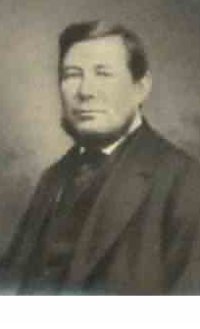 |
John W HILL John W Hill was born in Worcester around 1823. His parents are unknown. He was married to Charlotte and they were to have five children and the family moved to Yeovil around 1852. In 1854 John became partners with William Bide Jnr and the new firm that had been formed in Back Kingston (today's Higher Kingston) was called Bide & Hill. Although William Bide died in August 1864 the firm of Bide & Hill continued to use the name and was listed in the 1875 edition of the Post Office Directory as "Bide & Hill, Glove Manufacturers of Reckleford". In the same directory John was listed as "John Hill, Glove Manufacturer of Higher Kingston". |
John spent many years in local politics. He was elected to the Borough Council and served as Mayor of Yeovil from 1874 to 1876. In 1888 he was appointed as a Borough Magistrate. John Hill died in Yeovil on 23 March 1889. He was aged 66.
![]()
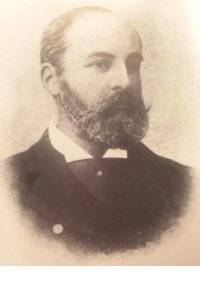 |
William Alfred HUNT William Alfred Hunt was born on 8 April 1845 in Yeovil, the only son of William Hunt senior and Mary née Mayo. He trained as a doctor at Kings College, London, and in 1868 he returned to Yeovil to work with his father specialising in oral and dental surgery. William Hunt became Yeovil Hospital's first specialist. Doctor Hunt became Surgeon-Dentist to the General Dispensary in 1869 and to the Fiveways Hospital from 1872 to 1904 before retiring to take up politics. |
In 1886, at the age of 30, he published the earliest English paper
on the use of
hypodermic
injection of
cocaine as a
local
anaesthetic. He
remained
unmarried and
practiced
dentistry with
his father at
Penn Villa.
A distinguished
practitioner, he
was president of
the British
Dental
Association in
1898 and of the
Odontological
Society of Great
Britain in
1902-1903.
In 1906 William
was appointed as
one of the first
co-optative
governors of the
Yeovil High
School for Girls,
a post he held
for five years.
In
1905 he become
Mayor of Yeovil,
the same year
his father
William Hunt
senior died,
aged 93, in Penn
Villa.
![]()
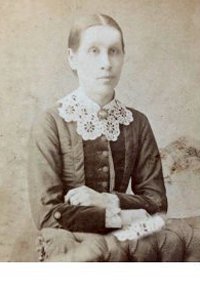 |
Amelia 'Millie' HUTCHINGS Amelia Hutchings, known as Millie, was born in Yeovil in the spring of 1862. She was the middle child of the seven children of tailor John Hutchings (1834-1896) and Sarah nee Minchington (1829-1908). By the time of the 1881 census, 18-year old Millie was living at 12 Peter Street and working as a general domestic servant to Harriett Morrish, the mistress of a preparatory school. The 1891 census recorded that Millie was now living in Sparrow Lane (today's Sparrow Road). 28-year old Millie gave her occupation as a dressmaker, like her mother. |
In the autumn of 1896, 34-year old Millie married railway porter William James Grant (b1869) at Yeovil. They were to have seven children. Millie died in Yeovil in the late spring of 1921. She was 59 years old.
![]()
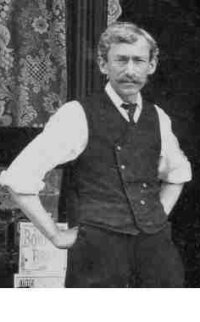 |
Joseph HYDE Joseph Hyde was born in Yeovil in 1866 and baptised at St John's church on 30 September 1866. He was the youngest of the six children of stonemason Francis Hyde (1825-1877) and Mary Ann née Mead (b1829) of Kingston. The
1881
census
recorded
14-year-old
Joseph,
working
as a
factory
hand in
a glove
factory.
However,
he
clearly
didn't
work in
the
gloving
industry
for
long,
since he
was
apprenticed
to
bicycle
and
sewing
machine
dealer
James Moffatt
of
High Street. |
In 1900, 34-year-old sewing machine repairer Joseph had entered a partnership with 23-year-old cycle engineer Fred Wakely. Joseph was listed living with the Wakely family at 17 Vicarage Street. Joseph concentrated on sewing machines, especially those used in the glove trade, while Fred dealt with the bicycle side of the business.
In the autumn of 1903, almost certainly at St Bartholomew's church at Crewkerne, Joseph married a (second?) cousin Emily Maria Hyde (1873-1919), of Crewkerne the daughter of George Hyde (1838-1921) and Jane née Courtenay (1840-1920). Joseph and Emily were to have three children, all born in Yeovil. Joseph Hyde died in the spring of 1954, in Yeovil. He was aged 87.
![]()
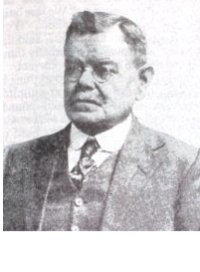 |
Benjamin
Joseph
JACOBS Benjamin Joseph Jacobs, known as Ben, was born in the spring of 1859 at Stoke St Mary, Somerset. He was the son of miller and farmer of 140 acres Joseph Jacobs (1818-1893) and Sarah née Sibley (1819-1882). On 25 September 1882, at Martock parish church, Ben married his cousin Sarah Sibley (1855-1911). They were to have three children |
Ben accepted an appointment as general foreman of the old Yeovil Foundry and General Engineering Works, owned by James Bazeley Petter. Ben Jacobs became the first chief designer of Petters Limited. In 1895 he collaborated with James Petter's twin sons Percy and Ernest Petter in the designing and building of the first Petter oil engine. This engine was one of the horizontal type developing 3 BHP and designed specifically to propel a 'horseless carriage'. In 1896 it was fitted to an old four wheeled Hill and Boll phaeton and was exhibited at the Lord Mayor's Show of that year as the 'Petter Horseless Carriage' - the first motor car with an internal combustion engine to be made in the United Kingdom. Ben Jacobs died on 26 April 1937, aged 77.
![]()
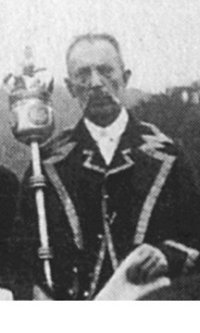 |
Henry
JESTY Henry Jesty was born in Yeovil in 1854, the son of carpenter John Jesty and Mary Ann nee Burge. Henry got a job as the hall-keeper of the Town Hall and was also the keeper of the Corn Exchange, the Meat Market and the Cheese Market behind the Town Hall, the whole complex extending from High Street all the way to South Street. Henry was also Yeovil's Town Crier and also worked as a bill poster. In his role as Town Crier he was also the Town's official Mace Bearer and as such attended almost all official functions in Yeovil from this time onwards |
In the summer of 1876 Henry married Eliza Ann Brooks at Yeovil. In 1883 Henry and Eliza had a daughter, but sadly Eliza died in the summer of 1886, aged just 36. In the summer of 1888 Henry married Mary Elizabeth Dominey of East Coker, at Yeovil. Mary died in Yeovil in the autumn of 1921 aged 61 and Henry died in Yeovil in the autumn of 1927, aged 73, sadly by committing suicide. He was found in an ante-room of the Town Hall with a length of rubber tubing in his mouth, and this was connected with a gas jet fully turned on.
![]()
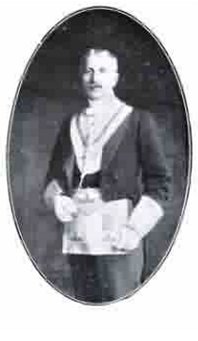 |
Joseph Nicholson JOHNSTON Joseph Nicholson Johnston, later working professionally as J Nicholson Johnston, was born on 22 March 1860 at Marylebone, London, Middlesex. He was youngest of the three children of of commercial traveller in silks Joseph Simpson Johnston (1822-1865) and Eliza Anne née Bishop (1828-1916), originally from Long Load, Somerset. Joseph trained as an architect and had moved to Yeovil by late 1891, at which time he was commissioned to draw up the plans and specifications for the restoration of the tower of St John's church. In 1893 Joseph was commissioned to design and supervise alterations to the Congregational School in Clarence Street. |
Another commission of this year was to design and supervise the building of the new Masonic Hall in Hendford. At this time his architectural practice was located in 21 Princes Street. In 1894 Joseph designed and supervised the building of Pen Mill Board School.
During the autumn of 1895, at Hampstead, Middlesex, Joseph married Constance Marion Watts (1872-1955). In 1896 Joseph designed and supervised the building of St Michael and All Angel's church in Brickyard Lane (today's St Michael's Avenue), which was completed in 1897. Joseph Nicholson Johnston died in Yeovil in 1942, aged 82.
![]()
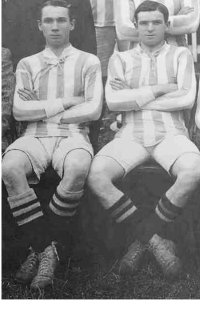 |
Charles
&
Reginald
LARCOMBE
Charles Percy Larcombe, known as Charlie, (at right in the photo) was born in 1889 and Reginald Frederick 'Dickie' Larcombe (at left in the photo) was born in 1892. Both were born at Weymouth, the sons of grocer Frederick 'Fred' Larcombe (1864-1946) and Annie Maude née Cawsey (1864-1924).
By 1900
the
family
had
moved to
Yeovil
and were
living
at 4
Great
Western
Terrace
and
presumably
at this
time
Fred had
his
grocery
shop in
Sherborne
Road on
the
corner
of St
Michael's
Avenue -
which
would by
known as
Larcombe's
Corner
for
generations. |
Charlie was well known in Yeovil for his footballing skills and the Western Gazette would later write that he "... was a former member of the Yeovil Town Football XI ... and was a fast and clever player." During 1912 Charlie emigrated to Toronto, Canada, where he worked for the Customs Service. After war broke out Charlie enlisted in the Canadian Infantry. He became a Signaller in the Signal Section of the 21st Battalion, East Ontario Regiment. While mending telephone wires in the trenches, Charlie was killed by a German shell during a bombardment of the trenches on 25 April 1917. He was aged 26.
Dickie enlisted and joined the City of London Yeomanry (Rough Riders) rising to the rank of 2nd Lieutenant. On 9 February 1918, while home on leave, the former Yeovil Town FC forward, Lieutenant Reginald 'Dickie' Larcombe, played centre forward for West Ham against Crystal Palace and scored the team's only goal in the one all draw. Dickie was reported missing, killed in action, on 10 September 1918. He was 26 years old.
![]()
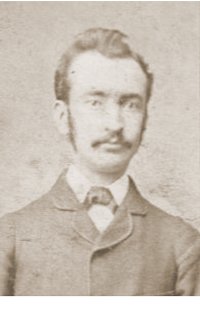 |
Adolphus LINNETT Born in Yeovil in the summer of 1855, Adolphus Linnett was the eldest of the six children of domestic gardener William Linnett (1832-1881) and Emma née Hodder (1832-1903), a dressmaker of Yeovil. In the 1871 census, 15-year-old Adolphus was listed as a solicitor's general clerk - a profession he was to remain in for the rest of his life. In the late summer of 1880, at Taunton, Adolphus married Esther Griffin Edmonds (1852-1940). They were to have four daughters. Adolphus Linnett died in Yeovil on 15 June 1912. He was 57 years old. Esther died in Yeovil during 1940, aged 87. |
![]()
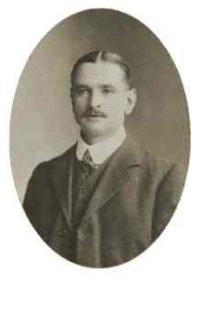 |
Thomas Edward LONEY Thomas Edward Loney was born in Wellington on 24 May 1866. He was the ninth of the ten children of baker William Loney (1829-1913) and Jane née Slade (1826-1916). Thomas moved to Yeovil and, by September 1891, he obtained the leasehold of premises of a shop with accommodation over, formerly the premises of butcher, Ernest G Hart. On 7 September
1908, at the
Baptist Chapel
in
South Street,
Thomas,
by now
aged 40,
married
27-year-old
Hannah
Mary
Maynard
(1881-1960).
|
In the 1911 census, William, Hannah and their seven-month-old son William, together with two butcher's apprentices and a house servant were listed living above the Middle Street premises. Thomas gave his occupation as a butcher. The family later moved to Cairnleath, 47a The Park. Thomas Loney died in Yeovil on 11 October 1930, aged 64. Hannah died in Yeovil on 1 February 1960, aged 78.
![]()
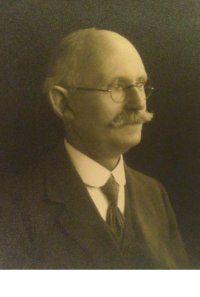 |
Alexander Stuart MACMILLAN Alexander Stuart MacMillan was born in Castle Cary on 12 January 1870. He was the eldest of the eight children of commercial clerk William Macmillan (1844-1911) and Emily née White (1844-1937). In
the 1891
census
21-year
old
Alexander
gave his
occupation
as
'Assistant
Sec[retary] of
Public Co.
Newspaper' - his
father was
company
secretary.
In 1896, at
Kingsbridge,
Devon, 26-year
old Alexander
married Edith
Clara Langdon
(1870-1960).
|
They set up home in Yeovil, at 56 The Avenue, where they were to have two children. In the 1901 census Alexander gave his occupation as 'Secretary to Newspaper and Printing & Publishing Co Ltd'. This was the Western Gazette. He progressed through the ranks of the Western Gazette's management and by 1939 was the Gazette's Managing Director. Alexander MacMillan died in Yeovil on 8 July 1949, aged 79.
![]()
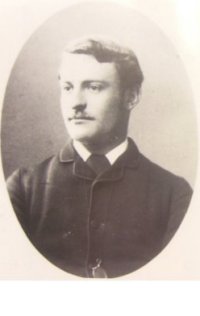 |
Dr Charles
James MARSH Charles James Marsh was born in 1856 at Stratford Subcastle, Salisbury, Wiltshire, the son of farmer John Marsh (b1823) and his wife Eliza (b1824). During the 1870s Charles left home and studied at St George's Hospital, Tooting, London. In
1880 he moved to
West Coker to
start work at
Yeovil's
Fiveways
Hospital.
This would be
the start of the
association
between Charles
Marsh, TD, LRCP,
MRCS, LM and
Yeovil's
hospitals that
would last until
1926. |
In 1883 Charles, in Devizes, Wiltshire, married Emily Neale May (b1864). They had a son and a daughter but sadly Emily died in Yeovil during the autumn of 1887. She was aged just 23. In 1890 Charles married Emily Sarah Jackson at Brighton, Sussex. Emily had been one of the early trainees at the Nightingale School of Nursing attached to St Thomas' Hospital. She was Matron of Fiveways Hospital from 1887 but resigned on her marriage to Charles, by this time one of the Consulting Surgeons at the hospital. Emily, died in 1917.
Charles became Senior Consulting Surgeon at the Fiveways Hospital and became one of the prime supporters in the drive for the new Yeovil General Hospital. In 1924 Charles began serving as Secretary of the new hospital and, although he retired from practice in 1926, he remained Secretary of the hospital until 1934. Dr Charles James Marsh died at Yeovil on 29 May 1940, aged 84.
![]()
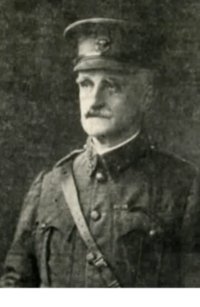 |
Colonel
William
MARSH William Marsh was born on 27 October 1850 at Imber, Wiltshire, the second son of farmer John Marsh (b1823) and his wife Eliza (b1824). William came to Yeovil in 1873, and in 1874, he married Agnes Elizabeth Waters (1851-1942) and were to have five children. During 1873, 74-year
old Yeovil
solicitor,
John Slade,
took on 47-year
old
William
Henry Mayo and
25-year old William Marsh as
partners. The
new firm of
Slade, Mayo &
Marsh operated
from
4 Church Street.
On John
Slade's
retirement,
the firm
was
renamed
Mayo &
Marsh. |
In 1887 the Mayo
& Marsh
association was
dissolved.
William
Marsh left to
set up his own
firm
and practiced
alone until 1892
when he was
joined by Harry
Macauley-Bennett
- the new firm
was known as
Marsh &
Macauley-Bennett.
![]()
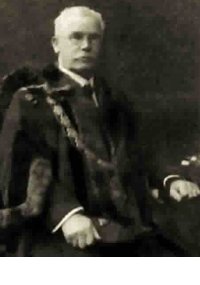 |
Jabez MATTHEWS Jabez
Matthews was
born in 1857 in
Pontypridd,
Glamorgan,
Wales, the
second of the
ten children of
insurance
superintendent
David Matthews
(1836-1908) and
Charlotte née
Williams
(1832-1901).
During
the
winter
of 1878
Jabez
married
Martha
Dixon
Taylor
(b1857)
at
Newport,
Pembrokeshire,
and were
eventually
to have
ten
children.
The
family
moved
around a
lot but
by the
time of
the 1901
census
were
living
in
Yeovil
and
Jabez
gave his
occupation
as
'Superintendent
of
Assurance
Agents;
Prudential
Assurance
Co'. |
Jabez was active in public life in Yeovil and from 1907 began serving on the Town Council. In 1916 he was elected as a Borough Magistrate. He was elected Mayor of Yeovil in 1922 and re-elected annually until 1925. On 22 December 1936, Jabez died in Yeovil, aged 78.
![]()
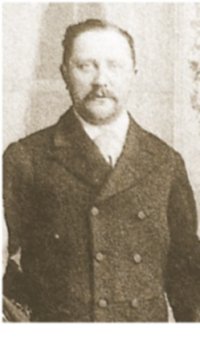 |
William Laurence MAYNARD William Laurence Maynard was born on 20 January 1816 in the St George, Hanover Square, London. He was the second son of gentleman William Maynard and Mary née Lawrence. On 21 March 1844 William married Hannah Hawkins Way, at St George, Hanover Square. At the time of his marriage William was described as a baker of Westminster. By
1845,
William
and
Hannah
had
moved to
Yeovil
and
William
set up a
bakery
in
Rotten
Row (now Market
Street). In the
1851
census,
William
described
his
occupation
as
'baker
employing
one man' |
In the summer of 1862, Maynard succeeded to Rendall's "Old-Established Pastry and Confectionary Business" in Silver Street. The bakery business continued in Rotten Row and the two premises were still being run throughout 1865 and 1866. In December 1866, William Maynard moved his established, family run business making pastries and confectionery and dealing in wines, to a new building in the Borough (technically High Street) close to the corner of Wine Street. By the time of Queen Victoria’s Golden Jubilee in 1887 the business, now called Maynard & Son, was large enough to provide a celebratory lunch for the people of Yeovil. William Laurence Maynard died in Yeovil on 28 July 1890 at his home in The Park.
![]()
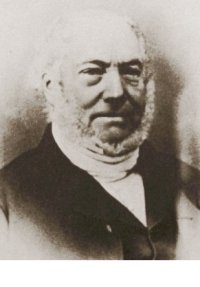 |
John Ryall MAYO
John
Ryall Mayo was
born on 31
December 1792 at
Nether Compton,
the son of
yeoman farmer
George Mayo
(1760-1825) and
his wife,
Christian
(1762-1826) who
was the daughter
of
John Ryall.
It was this John
Ryall who was a
wealthy glove
manufacturer and
owner of
Old
Sarum House that
John would
inherit. In 1814
he married
Elizabeth
Whitmash Randall
(1791-1822) and
they had four
children.
Elizabeth died
in 1822 and in
1824 he married
her cousin
Penelope
Worsfold Randall
(1804-1867).
They had five
children. |
In 1821 and 1822 he served as a Churchwarden of St John's church with Robert Tucker. Mayo was also a trustee of Woborn's Almshouse, John Mayo became a Surveyor of Highways and was. nominated, like his brother George, as a Town Improvement Commissioner. The two Mayo brothers, together with John Greenham (glove manufacturer, burgess and Portreeve in 1797) were exceptional in their work as Commissioners. After Greenham's death on 1838 John Ryall Mayo acted almost continuously as Chairman until the Commission ceased to exist when Yeovil became a municipal borough in 1854.
He became the first Mayor of Yeovil in 1854. Shortly afterwards the Lord Chancellor appointed Mayo, along with Frederick Greenham and William Bide, as Magistrates for the Borough. He died in Old Sarum House on 6 February 1870 aged 77
![]()
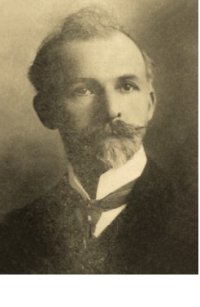 |
William Richard Edwards MITCHELMORE William Richard Edwards Mitchelmore was born in April 1863 in Kingsbridge, Devon and by 1881 he was employed as an indoors farm servant at Strete Farm, Blackawton. He married on 1 February 1887 at the Baptist Chapel, Union Street, Wells, Ellen Annie Thomas of Wells. At the time of his marriage he gave his occupation as butler. William and Ellen were to have two children. In
March
1887 he
opened
the
Abbey
Hotel &
Coffee
Tavern,
a
temperance
(that is
alcohol-free)
establishment
in
Glastonbury. |
In 1895 he moved to Yeovil, taking over the Albany Temperance Hotel & Coffee Tavern at 17 Middle Street. Between 1914 and 1919 he was listed as the hotel keeper of the Albany Temperance Hotel & Coffee Tavern in Middle Street and also the Fernleigh Commercial Temperance Hotel, on the corner of Middle Street and Station Road.
In 1907 he entered local politics and was elected to Yeovil Town Council and was elected mayor of Yeovil and held the position between 1918 and 1921. Being the first of Yeovil's mayors to be elected after the First World War, he was known as the "Peace Mayor". He died, aged 75, on 18 July 1939 in the Municipal Offices, as a magistrate he was waiting to go into court at the time of his death.
![]()
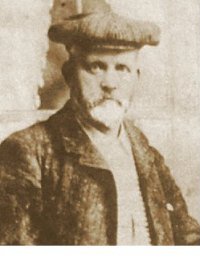 |
James MOFFAT James
Moffat was born
in Wanlockhead, Dumfries,
Scotland
around
1839. By
the time
he was
in his
early
20s he
had
moved
south
and was
living
in
Sherborne,
Dorset.
In 1869,
at
Axminster,
James
married
Emma
Sellers
and in
the 1871
census
James
and Emma
were
listed
in
High Street
where
James
listed
his
occupation
as a
draper.
In the
1881
census
James
now
listed
his
occupation
as a
'Sewing
Machine
Dealer &
Fancy
Draper'.
Emma
died in
1887
aged 41,
possibly
in
childbirth. |
In Whitby's
Yeovil Almanack
Advertiser
of 1907 James
was advertising
sewing machines
and bicycles,
but he had also
expanded into
selling mail
carts, laundry
appliances,
motoring
sundries and
petrol. James
retired around
1911, but died
29 March 1915.
His sons, Hubert
and Percy,
continued to run
the High Street
shop.
![]()
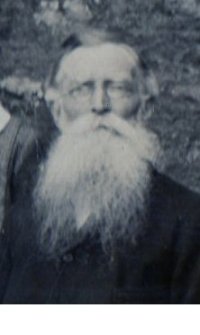 |
Henry MONK Henry Monk was born in 1833 in Harrow Weald, Middlesex, the son of James Monk and his wife Mary. In the 1851 census, 18-year-old Henry was a student at St Andrews College, Harrow. In May 1859 Henry was elected to the post of Master of the Yeovil Charity School. On 9
January
1860, at
the age
of 27,
Henry
married
Elizabeth
Henrietta
Hawkins
(b1834)
at
Harrow
All
Saints
Church,
Harrow
Weald.
They
were to
have
nine
children.
In the
1861
census
Henry
and
Elizabeth
were
living
on
Sherborne
Road.
Henry
gave his
occupation
as
'Grammar
Schoolmaster'
while
Elizabeth
listed
her
occupation
as
'Superannuated
from the
War
Department'.
|
During the 1860s Henry and Elizabeth moved to Hendford Hill where Henry opened his own school. During the 1870s Henry and his family moved to 8 Hendford, today known as Flowers House, which was to become famous towards the end of the nineteenth century as Mr Monk's Grammar School. Henry moved his school from Hendford to the Chantry in Church Path in 1897. Elizabeth died in the autumn of 1911, aged 78. Henry then moved to Stratton on the Fosse where he died on 11 January 1921, aged 88.
![]()
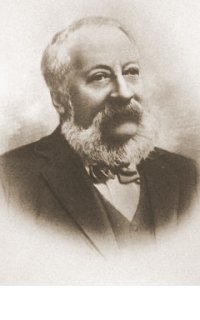 |
Joseph Chaffey MOORE Joseph Chaffey Moore was born about 1833 at West Coker. He was the son of attorney at law Thomas Moore and his wife Elizabeth. In Yeovil, during the summer of 1857, Joseph, by now a solicitor, married Elizabeth Webb Jekyll of West Coker. They lived at 28 Kingston. Joseph entered
local politics
in the late
1850s and served
as
mayor from
1867 to 1869,
from 1871 to
1872 and was
elected for a
third term,
serving from
1886 to 1887. In
1875 he was
appointed as a
Borough
Magistrate.
|
In the spring of 1884, Elizabeth died in Yeovil at the age of 50 and in the autumn of the following year Joseph married Mary Barns, eighteen years his junior, at Highworth, Wiltshire. Joseph Chaffey Moore died at Headington, Oxfordshire, in November 1901 aged 68.
![]()
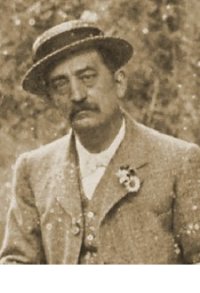 |
George Frederick MUNFORD George Frederick Munford was born in Crewkerne, Somerset, in 1847, the son of plumber, glazier and painter James Munford and his wife Eliza. George was apprenticed to GPR Pulman, the founder and then proprietor of Pulman's Weekly News. In
the
summer
of 1873
George
married
Julia
Bishop
at
Exeter.
They
were to
have one
daughter.
In 1884
he
joined
the head
office
of the Western
Gazette and
Pulman's Weekly
News where
after serving as
a reporter and a
sub-editor, he
was appointed
editor in 1894. |
Julia died early in 1916 in Yeovil, aged 69. Towards the end of December 1922 George retired, having spent 28 years as editor of the Western Gazette. Sadly he died just one week later at his home, York Cottage, on 6 January 1923.
![]()
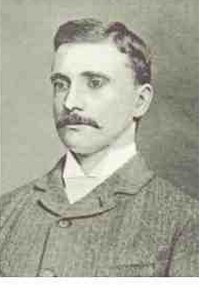 |
Theodore NEAL Theodore Neal was born in 1860 at Sherston Magna, Wiltshire, the son of house painter Henry Neal (1825-1885) and his wife Elizabeth Margaret née Weight (1823-1917).
In the
autumn
of 1888
Theodore
married
Rose
Louisa
Morris
at
Richmond,
Surrey,
but by
31
August
1888
Theodore
had
taken
over the
ironmongery
business
of Cox &
Son with
premises in both
28
Middle Street
and 20
Vicarage Street.
He was listed
as an ironmonger
twice in
Whitby's Yeovil
Almanack
Advertiser of
1889. |
By the early 1890s Theodore Neal had formed a partnership with Charles Williams and in their adverts in Whitby's Yeovil Almanack Advertiser of the early 1890s a third address, 119 Middle Street, appears. Although Neal & Williams Ltd maintained a presence in Yeovil, by 1911 Theodore had moved and died in 1942 at the Wirral, Cheshire. He was aged 82.
Charles Williams died in Yeovil in 1950 but the firm continued and by 1962 Neal & Williams used their Vicarage Street premises as a builder's merchants and the premises at Middle Street as a general ironmongery outlet.
![]()
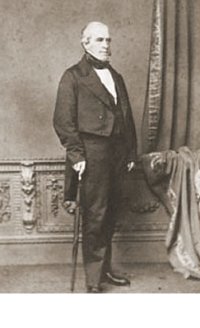 |
Edwin NEWMAN Edwin Newman was born in 1803 in Milborne Port, and baptised there on 29 October 1803. He was the son of Edwin Sandys Newman (1762-1836) and his wife Frances Tucker née Lyde. Edwin Jnr was educated at Sherborne School and attended the school around 1815. He entered into articles with James Parsons, attorney and solicitor of Somerton, for a period of five years. On 19
April
1828 at
West
Coker,
Edwin
married
Charlotte
Jekyll,
daughter
of Rev
George
Jekyll
(c1777-1843)
of West
Coker
and they
were to
have
twelve
children
born
between
1829 and
1849. |
Edwin was a member of Yeovil's Vestry and became a Town Commissioner in 1830 and he started a legal practice in Yeovil around the same time. By 1839 he was in partnership with Thomas Lyon and their company was called Newman & Lyon until at least 1875 (at which time Edwin was 72 and Thomas was 61). Edwin bought Hendford Manor in 1840 and the Somerset Gazette Directory of that year recorded him as an Attorney of Hendford.
Charlotte died in the spring of 1875 aged 68 and in 1876, Edwin married 65-year old Catherine Augusta Paynter née Coleman, widow of Francis Paynter. Edwin suffered a severe financial blow in 1880 due to his head clerk making off with the firm's funds. Newman's second wife Catherine died in September 1880 and Edwin Newman died on 22 January 1885 aged 82.
![]()
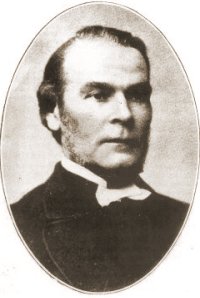 |
Reverend Samuel NEWNAM In 1912 the Newnam Memorial Hall and Schools were built alongside the Baptist Chapel in South Street. It was named in memory of Rev Samuel Newnam, minister of the adjacent Baptist chapel from 1883 until 1896. Samuel Newnam resigned as pastor in 1889 after serving over 15 years at Yeovil, and over 50 years altogether in the Ministry.
He retired to
Fivehead and
died there on 26
May 1907. |
![]()
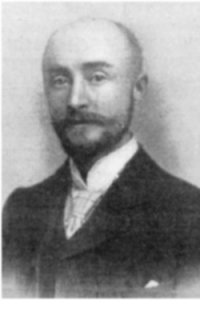 |
Arthur NEWTON Arthur Newton
was born in 1863
at his father's
dairy farm at
High Legh,
Cheshire, the
son of farmer
Edward Newton (b
1828) and
Margaret née
Percival (b
1828). Sadly his
mother died the
following year
and in 1868 his
father married
Martha Burman.
By the
time of
the 1881
census
18-year
old
Alfred
had left
home and
was
lodging
with,
and
working
as a
chemist's
apprentice
for,
Charles
M Blades
a
chemist
and
druggist
of
Winnington,
Cheshire.
During the next
ten years Alfred
moved to Yeovil
and the 1891
census recorded
him living in
the
accommodation
above the
Medical Hall
in the
Borough with
the
families
of
Alfred
Wright
and
Oswald
Gatward. |
Arthur was listed as a chemist & druggist and was clearly working at the firm of Gatward & Wright. Although the census listed 28-year old Arthur as married, in fact he was still single. He was to marry in Yeovil, in the winter of 1895, Mary Patch (1867-1938), the Merriott-born daughter of William and Jane Patch. By the time of the 1901 census Arthur and Mary had moved to 75 Hendford where Arthur set up his own chemist and druggist business, opening his chemist shop on 8 August 1892. Arthur Newton died in Yeovil in the winter of 1950. He was aged 88. The business remained in the family until 1968.
![]()
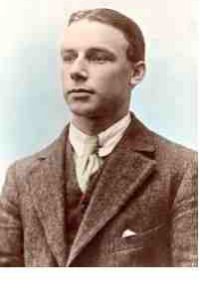 |
Cary
Reginald OSTLER Cary Reginald Ostler was born on 27 October 1896 at East Coker and was the fourth of the six children of farm carter Alfred Charles Ostler (1869-1935) and his second wife Emma Christian née Gill (1870-1954), known as Christian. At the age of
11, Cary started
work on a farm.
In the 1911
census he was
listed as a
15-year-old
assistant cowman
on a farm at
Childhay,
Crewkerne,
where he
remained
until he
joined
the army
in 1914,
at the
outbreak
of the
First
World
War -
although
he was
under
age when
he
enlisted.
Cary
became a
Private
in the
1st/5th
Battalion
of the
Somerset
Light
Infantry
and
served
in India
throughout
the war. |
On 25 December 1923, at the Congregational church in Princes Street, 27-year-old Cary married 23-year-old Dora Annie Alexandra Cottle (1902-1970), the daughter of John and Elizabeth Cottle. Dora was a leather glove machinist of 7 Frederick Place and after their wedding, Cary and Dora lived with her parents.
Cary worked for glove manufacturers Atherton & Clothier of Court Ash for thirty years. Cary and Dora eventually moved to 86 Northbrook Road, where Dora died in 1969, aged 67. Cary died at home during the winter of 1978. He was 82 years old.
![]()
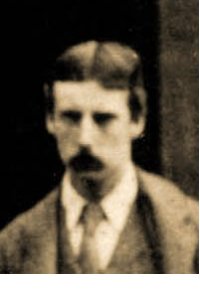 |
James Bernard PAYNTER James Bernard Paynter was born on 28 December 1850 at Penzance, Cornwall. He was the son of solicitor Francis 'Frank' Paynter of Clarence House, Penzance, and his wife Catherine Augusta née Coleman. The photograph at left shows James aged about 26, circa 1876. Like his father and brothers, James was a solicitor.
The 1881 Yeovil
census shows
James as a
lodger at 32
Hendford, and
employed as a
solicitor.
Indeed it seems
likely that he
became a partner
in
Edwin
Newman's law
firm that same
year.
|
Five years previously, he had become Edwin's step-son when his widowed mother Catherine Augusta Paynter married the recently widowed Edwin. The firm was renamed Newman Jeans Paynter Newman and Gould, being listed in 1883. The partners were Edwin Newman, by this time aged 80, John Locke Jeans, James Bernard Paynter, Charles Octavius Newman (Edwin's son) and Frederick JM Gould, aged 26. Following Edwin Newman's death in 1885 Hendford Manor was bought by James (who, being the son of Newman's second wife, was also Newman's son-in-law) and the solicitors practice continued operating from there.
James married late in life. In 1900, at the age of 50, he married 25-year old Maud Josephine Beckton (1867-1942) of Manchester and in the 1901 census they were listed living at Hendford Manor together with six servants. James died in Yeovil in 1927, aged 77.
![]()
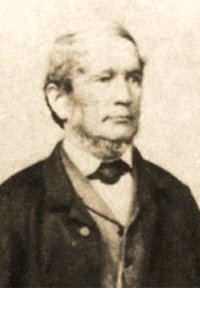 |
John PERRY John Perry was born around 1810 in Somerton and moved to Yeovil around 1839. By the time of the 1851 census John had moved his family to Hannam's Lane (today's Tabernacle Lane) where he took over Bragg's smithy. John gave his occupation as blacksmith journeyman. John regarded himself as a 'Technical Blacksmith' and created intricate clockwork mechanisms that worked by a penny-in-the-slot arrangement. Certainly by
1856 John Perry
was running
Perry's
Family &
Commercial
Temperance Hotel
in
South Street
situated
between
the
Globe and Crown
and the
Baptist Chapel. |
In August 1865 Hanham & Gillett sold their ironmongery establishment in the Borough to John Petter and at this time John Perry, having been the manager of Hanham & Gillett's workshops for some 23 years, set up his own Engineering business in South Street in partnership with his son. John Perry died in Yeovil during the spring of 1875 aged 66.
![]()
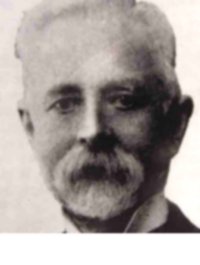 |
James Bazeley PETTER James Bazeley
Petter was born
in Barnstaple,
Devon in 1847,
the son of
John
Petter. His
father moved his
family to Yeovil
around 1865 when
he purchased the
ironmongery
business of
Hannam & Gillet
in the
Borough.
In the
autumn of 1870
James married
Charlotte Waddams Branscombe of
Bristol, the
daughter of
Henry Branscombe,
a rubber
merchant,
and his
wife
Elizabeth.
They
were to
have
fifteen
children.
His
father
gave
James
the
ironmongery
business
as a
wedding
present
although
he was
advertising
the
business
as "John
Petter,
Ironmonger"
for
years to
come |
In the 1871 census, 24-year old James gave his occupation as "Ironmonger employing 11 men and 8 boys". By 1872 Petter had acquired the Yeovil Foundry and Engineering Works, making agricultural machinery, from William Rowe who was retiring. Petter took the manager, Henry Francis Edgar, known as Frank, as a partner in the business. Around 1881 James designed a modern and efficient fire grate which he called the 'Nautilus' and he founded the Nautilus Stove Company which made his fire grates and kitchen ranges at his Nautilus Grate Works in Hendford, next door to Ayr House and opposite the Manor Hotel. Petter and Edgar bought the Yeovil Iron and Brass Foundry, on the corner or Huish and Clarence Street (now under Tesco's car park).
By 1892, James' twin sons Ernest and Percival (known as Percy) had designed and produced a self-propelled oil engine and in 1895 they developed a new engine of one horse-power designed specifically to propel a 'horseless carriage'. They designed the first motor car with an internal combustion engine to be made in the United Kingdom using a converted four wheel Hill and Boll horse-drawn phaeton and a 3hp Petter horizontal oil engine.
James retired in 1901 and died in Yeovil in 1906. Space here precludes an in-depth review of James Petter's company, for which click here.
![]()
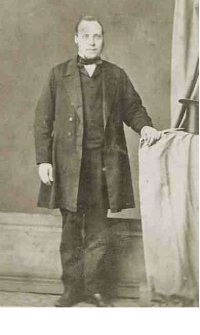 |
William PHILLIPS William Phillips was born in Carmarthen, Wales, in 1825. On 10 December 1851, at Anvil Street Chapel, Bristol, he married Ann Tayler (b1821), originally of Dursley, Gloucestershire. William and Ann were to have two children; Annioe Sophia and William Jnr. By 1871 William had moved his family to Yeovil. The
family
lived
above
William's
shop
premises
in
High Street,,
together
with
four
draper's
assistants
and a
domestic
servant.
47-year
old
William
gave his
occupation
as a
draper. |
In the late 1880s, William Snr retired and William Jnr carried on with the High Street business. William Snr and Ann moved to Weston-super-Mare, where he was described as a gentleman. He died in Weston on 20 June 1890.
![]()
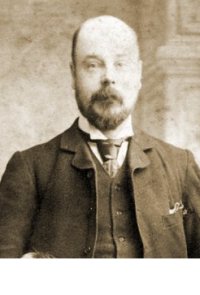 |
Charles Thomas PITCHER Charles Thomas Pitcher was born on 16 November 1855 in Southwark, London, the son of brewer Isaac Pitcher (1810-1862) and his wife, Mary Maria née Harvey (b1821) from Norwich, Norfolk. In 1884 he was working as a commercial traveller when he married Ada Helen Thristle (1863-1944) in Minehead. She was the daughter of hotelier Thomas Thristle (1831-1890) and Elizabeth née Fish (1829-1887). In
the 1891
census
Charles
was
listed
as a
commercial
traveller
and was
living
in East
Ham,
London,
with Ada
and
their
children. |
In 1899 the family moved to Yeovil where Charles became proprietor of the Mermaid Hotel from 1899 until his retirement in 1919. For several years Charles represented the South Ward on Yeovil Town Council. He was a founder member of Yeovil Bowling Club. On retirement Charles and Ada moved to Taunton, where Charles died on 16 August 1937, aged 81.
![]()
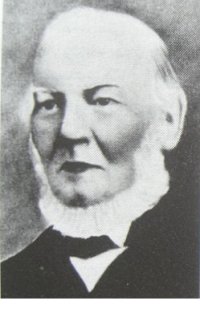 |
Charles PITTARD Charles Pittard was born in Martock about 1812 and first started working as a leather dresser in Yeovil in 1826, when he was about 14. In 1840 he
was listed in
the Somerset
Gazette Directory as a
glover living
and working in
Bond
Street and the 1841
census recorded
that he was
living in Bond
Street with his
wife Ann, 9
years his
senior,
daughters Ann
aged 4 and Mary
aged 1. His
daughter Ann
died in 1843 and
his wife died in
the spring of
1849. In the
winter of that
year Charles
married Eliza
Thorne at
Dorchester. |
A leather dressing warehouse and office was acquired by Charles Pittard in 1848 and he remained its sole owner until his death in 1867, after which it passed to his two sons, Charles Wreford and Ebenezer then aged 22 and 19 respectively (see below). The building, which survives today, had previously been the glove factory and dressing yard of Hammond & Pickford. In 1858 Charles Pittard purchased an area of land south of the Sherborne road at Penfield, also known as Dykes Penn. His sons, Charles and Ebenezer, added to the site some five years after his death in Yeovil during 1867, aged 55.
![]()
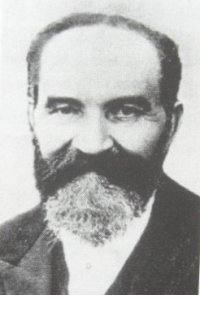 |
Charles Wreford PITTARD Charles Wreford Pittard was born in Yeovil in 1844, the eldest son of leather dresser Charles Pittard (see above)and his first wife Ann née Wreford. When Charles Pittard senior died in 1867 Charles Wreford Pittard and his younger brother, Ebenezer, succeeded to their father's leather business. In March 1868 Charles was married to Fanny Mogridge at Newton Abbot, Devon. They were to have seven children. In
1858
Charles
Pittard
had
purchased
an area
of land
south of
the
Sherborne
road at
Penfield,
also
known as
Dyke's
Penn.
|
Charles and Ebenezer added to the site some five years after his death and built a leather dressing yard. From this time onwards, for the next 40 years or so, the Pittard brothers operated two sites with the leather being dressed at the Penfield works and then moved to be finished at the Lower Middle Street factory. In 1891 Ebenezer and Charles went their own separate ways, and the partnership was finally dissolved in March 1893. Charles stayed on at Middle Street and Ebenezer established his own leather dressing yard at the bottom of Mill Lane.
Charles Wreford Pittard was elected to the Town Council, serving a total of 25 years. In 1897 he was made an Alderman and although he was offered the office of Mayor, he declined it. Charles died in Yeovil on 16 September 1912.
![]()
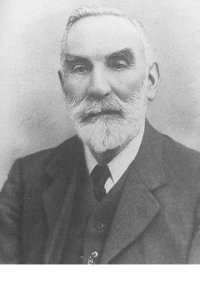 |
Ebenezer PITTARD Ebenezer Pittard was born in Yeovil in 1847, the son of leather dresser Charles Pittard and his first wife Ann née Wreford. In 1869 Ebenezer married Sarah Jane Wing, daughter of William Wing of Buckfastleigh, Devon, and his wife Mary. The
1881
census
recorded
Ebenezer
and
Sarah
living
at 52
Middle
Street,
next
door-but-one
to the
South
Western Arms,
with
their
children.
Ebenezer
described
his
occupation
as
leather
merchant.
|
Living next door was his brother Charles Pittard, his wife Fanny, and their children. The porte-cochere between the brothers' two properties led to their leather factory. In 1891 Ebenezer and Charles went their own separate ways and Ebenezer established his own leather dressing yard at the bottom of Mill Lane.
Ebenezer had long been associated with elementary education in Yeovil and served on the Yeovil School Board and its successors from 1880 until 1920. He was also a teacher at the South Street Baptist Church Sunday School for more than 50 years. He was made a Freeman of the Borough in 1926 in recognition of his services to education and to the welfare of young children. Ebenezer Pittard died in Yeovil in 1929 at the age of 82.
![]()
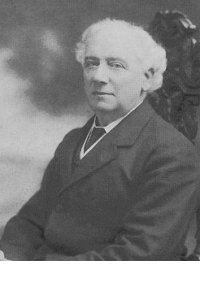 |
Walter RAYMOND Walter
Raymond was born
on 13 March 1852
in
Vicarage
Street,
the son of glove
manufacturer
Cuthbert
Raymond,
although
most of
his
ancestors
had been
farmers
at
Podimore.
Two years after
his birth
Walter's mother
and sister died
of typhoid and
Walter was sent
to live with his
grandparents in
Marston Magna.
Walter also got
typhoid but made
a recovery.
His father built
up his own glove
manufacturing
business and
Walter joined it
around 1875 but
was never really
interested in
gloving. In 1878
Walter married Mary
Johnston. They
were to
have
eight
children. |
Walter and Mary moved to Sutherland House, Preston Plucknett, where he could devote himself to country writing. His books were very simply written with no convoluted plots or wordy descriptions. Nevertheless, his spontaneous and charming style was well suited to Somerset country life, the chief subject of his writing, and garnered him much critical acclaim. In 1905 Walter moved his family to London but also took the lease of a cottage at Withypool on Exmoor. Until 1914 he spent more and more of his time at Withypool and most of his subsequent books were written there. Walter Raymond died in Southampton on 2 April 1931, aged 79.
![]()
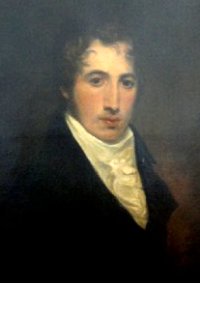 |
Francis Theophilus ROBINS
Francis
Theophilus
Robins,
born in
1787,
was the
only son
of
Reverend
Thomas
and
Marianne
Robins.
In 1805, Francis
was articled for
five years to
the law firm of
Edmund Batten
and
John Batten.
On 9
December 1813
Francis married
Elizabeth
Proctor Upton
(1791-1859), the
daughter of
Yeovil solicitor
George Proctor
Upton
(1763-1827)
and
Eleanor
née
Leach
(1761-1848).
Francis
and
Elizabeth
were to
have at
least
five
children.
Francis
worked
in his
father-in-law's
law
firm,
most
likely
before
his
marriage
but
certainly
afterwards.
After
the
death of
George
Proctor
Upton in
1827
Francis
became
head of
the law
firm. |
In 1831 there were riots in England when Parliament decided against reform to give Britain's industrial cities and towns better representation. Many of the solicitors in Yeovil were active anti-Reformers and had been professional election agents of Lord Ashley. Consequently these were the first to be singled out by an angry mob on the night of Friday, 21 October 1831, in what was to become known as the Yeovil Reform Riot of 1831. The mob attacked the home of Francis Robins as well as the homes of Edwin Newman, William Lambert White, John Slade and Edwin Tomkins. The damage done to Francis' property amounted to more than £300 (about £24,000 at today's value).
Francis Theophilus Robins, Esq. died at Yeovil, on 5 January 1849, aged 62.
![]()
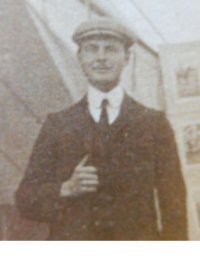 |
William Alexander Mitchelson ROSS William Alexander Mitchelson Ross was born on 29 March 1883 at St Denys, Southampton, Hampshire. He was the son of Scottish artist Alexander Mitchelson Ross (1816-1907) and Maria née Biddlecombe (b1861 - 45 years his junior!!). By
1906 he
was
living
in
Yeovil
working
as a
photographer.
On 15
April
1908 at
Holy
Trinity
church,
William
married
Rose
Wilhelmina
Langdon
(1885-1968)
of
Yeovil.
They
were to
have
three
children |
William left Yeovil between 1914 and 1918, moving to Amesbury, Wiltshire. He had a tent studio set up on Salisbury Plain during the Great War in order for soldiers to have their photographs taken, to send back to loved ones before they set off for war. He later moved to the small village of Shrewton, Wiltshire, set within Salisbury Plain. Here he he ran the Supply Stores in High Street as a grocer and general dealer. William died in Shrewton on 18 August 1957, aged 74.
![]()
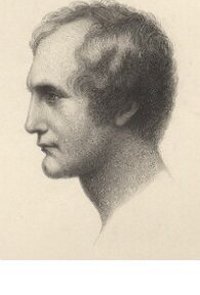 |
Thomas Southwood SMITH Thomas Southwood Smith, sometimes professionally known as Southwood Smith, was born on 21 December 1788 in Martock. He was the son of William Smith and Catherine née Southwood (1763-1840). His parents were
members of a
strict sect of
Calvinist
dissenters and
in 1798 they
became very
friendly with
the Reverend
William Blake,
who i
was to become a
powerful
influence in the
life of the
growing boy,
directing his
education and
moulding his
opinions and
character. |
In 1803, he entered the Baptist academy at Bristol with the intention of becoming a minister. Smith eventually rebelled against his inherited Calvinism and left the academy in 1808. His parents cut him off, and he never saw them again. On 25 May 1808, at Clifton, Gloucestershire, he married Anne Read (1788-1812). Thomas and Anne were to have two children. In 1812, at the age of 24, Anne died.
During 1816 he moved to Yeovil where he became minister at the Unitarian Chapel in Vicarage Street. At the same time he was practicing medicine at his home in Kingston that would later become the Kingston School, later Yeovil County School. On Wednesday, 4 August 1819, at Hackney, London, Thomas married Mary Christie (1798-1858). They would have one son. Thomas separated from his second wife during the 1830s, and then lived for the rest of his life with the artist Margaret Gillies (1803-1887). On 10 December 1861, while visiting his daughter Emily in Italy, Thomas died in Florence. He was 72 years old. He is buried in the protestant cemetery outside the Porta Pinti, Florence, Italy.
![]()
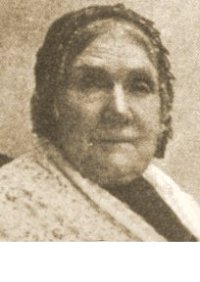 |
Martha Amelia SOFTLEY Martha Amelia Softley was born in 1830 in Tufnell Park, Holloway, Middlesex. In the 1851 census, at the age of 21, Martha was lodging in Kingston and listed her occupation as a schoolmistress. Indeed, it was in 1851 that Martha started her own school, later to become The Park School, at Ashgrove, Mudford Road.
The
purpose
of her
school
was to
impart a
good
general
education
for
girls,
founded
on a
Christian
basis.
Shortly
after
founding
her
school
at
Ashgrove,
she
moved to
Higher Kingston.
However,
by 1869,
the
school
was in
The
Park. |
In the spring of 1871 at Yeovil Martha married 'Minister of the Gospel' William Henry Bennet (b 1843), originally from Ashford, Middlesex. It is known that they became involved in missionary work, which is probably the reason they don't appear in the next two censuses. By 1901 Martha and William were back at The Park where William listed his occupation as Minister of the Gospel and Martha gave hers as Principal of Girls School. Martha finally retired in 1917 and died in Yeovil on 8 January 1919 at the age of 88. William died on 13 December 1920, aged 77. They had been married for 46 years but had no children.
![]()
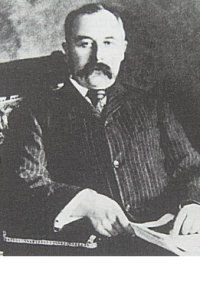 |
Herbert William SOUTHCOMBE Herbert William Southcombe was born in Stoke sub Hamdon in 1859. He was the son of glove manufacturer Richard Southcombe and his first wife whose name is unknown. By
1881
Herbert
had left
home and
was
listed
in the
census
at 24
Sherborne
Road,
Yeovil.
He was
22 years
old and
listed
his
occupation
as glove
manufacturer.
In fact
he had
joined
the
company
of
Thring & Luffman,
which
then
became
Thring,
Luffman,
Southcombe
& Co.
|
In the summer of 1882 Herbert married Mary Picken Phillpott in Kent, and on the death of his father in 1885, together with his brother, he inherited his father's glove manufacturing business at Stoke sub Hamdon. Together they created the company of Southcombe Brothers.
In the early 1880s Herbert became interested in local politics and was elected to the town council. He served as mayor of Yeovil from 1889 to 1890. In 1894 he was appointed as a Borough Magistrate. By 1911 Herbert had retired to Brighton. He died in Surrey in early 1944, aged 85.
![]()
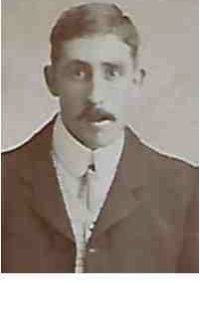 |
Henry John 'Harry' SPINNER Henry John Spinner, known as Harry, was born in the spring of 1880 at Worcester - the other major glove manufacturing town in England. He was the youngest of the six children of inn keeper and glover George Spinner (1843-1924) and Ellen née Taylor (1844-1904). In the autumn of
1907, at
Worcester, Harry
married Harriett
Alice Walker.
They moved to
Yeovil after
their marriage
and set up home
at 26
Vincent Street.
They had
a
daughter
and
Harry
worked
as a
glove
cutter.
|
Already having made several Atlantic crossings in the past, in the spring of 1912 Harry prepared to make another crossing with the intention of visiting Gloversville, New York, USA. Harry joined the Titanic, sailing Third Class. 32-year old Harry Spinner went down with the Titanic. His body was not recovered.
![]()
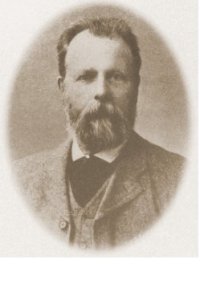 |
Henry STIBY Henry Stiby was born in Acreman Street, Sherborne on 19 January 1843, the fourth and youngest son of farmer Robert Stiby (1799-1866) and Frances Moore née Brook (1813-1896). Robert Stiby
owned a
large, 670 acre
farm at
Stalbridge. On
his
father's
death in
1866,
Henry
took
over the
day-to-day
running
of the
farm
while in
his very
early
twenties.
He
didn't
take to
farming,
so left
the
family
farm and
moved to
Devizes
where he
became
apprenticed
to an
ironmonger.
|
When he moved to Yeovil Stiby, clearly affluent from the sale of the family farm, lived in a large house on the southeast corner of Peter Street and Union Street with his widowed mother. Both Henry and his partner Thomas Denner retired in 1894. After retirement Henry had more time to devote to his wide-ranging interests which included photography and he left a fine record of Yeovil and its surroundings from the 1880's onwards. He donated his collection of guns, coins, etc. to the fledgling Wyndham museum which was to become the Yeovil museum.
In 1902 he was elected to the town council and was elected Mayor in 1904 and became a Justice of the Peace in 1906. He became an Alderman in 1907 and retired from the council in 1909. In 1926 he was awarded the Honorary Freedom of the Borough of Yeovil in recognition of his services to the town and Stiby Road, formerly known as Lower Larkhill Road and Glyde Road, is named after him. Henry died on his birthday, 19 January 1934, aged 91
![]()
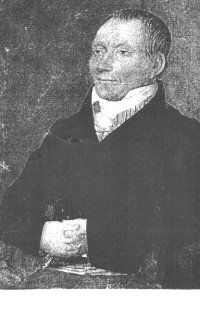 |
Nathaniel SYDENHAM Nathaniel Sydenham, known as Nathan, was born in Honiton, Devon, in May 1760. He was the son (and sixth of eight children) of Hugh Sydenham (1732-1793) and Mary née Moore (1732-1788). Little is known of Nathan's early life other than he was a cordwainer, or shoemaker. Nathan married Hannah Shene (1763-1805) on 17 July 1785 in Devon and they were to have nine children. He had moved to Yeovil by 1796.
Hannah
died in
1805 and
on 12
October
1828, at
the age
of 68,
he
married
Susannah
Marsh at
Yeovil.
Susannah,
known as
Susan,
was 23
years
younger
than
Nathan.
|
Nathan Sydenham died in Yeovil on 29 April 1860 of 'natural decay', about a month short of reaching his 100th birthday (despite what his death certificate says).
![]()
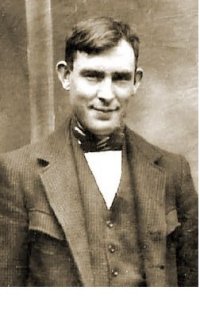 |
Benjamin THORNE Benjamin Thorne, known as Ben, was born in Yeovil on 18 August 1895 but very little is known about his early life. His parents were travellers; his father William came from Somerset, his mother Ellen was Irish and they married in Bristol in 1919, settling in Yeovil around 1925-26.
However Ben
Thorne became a
familiar sight
around Yeovil
with his knife
and scissor
grinding
machine. For
years he would
push his little
hand-cart around
the town and
sharpen blades
of all
descriptions for
both companies
and individuals. |
He served in the Somerset Light Infantry in World War One and later ran a lodging house at 111 Park Street (the former Cross Keys beerhouse). He bred budgerigars and ran a smallholding at the bottom of the garden and he even built a boxing ring in the basement where he held boxing events. He served in the 3rd Somerset Yeovil Home Guard, Q Company, 5 Platoon.
![]()
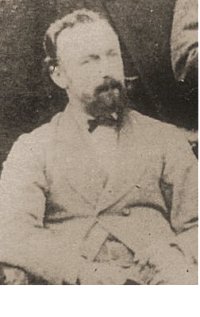 |
Charles TITE Charles Tite was born in Taunton in 1842, son of publican Walter Tite (1777-1855) and his wife Elizabeth née Higgins (1796-1870). In the spring of 1869 Charles, aged 27, married Hannah Sophia Cattle at Langport. She was the daughter of James and Sophia Cattle In 1863
Charles
Clinker
(see
above) founded
his own
newspaper which
he called 'The
Western
Gazette'.
Charles
Tite
went
into
partnership
with
Charles
Clinker,
and
together
they
acquired
the
rival
Yeovil
newspaper,
the
century-old
Western
Flying
Post. |
They combined the two papers under the heading of 'The Western Gazette and Flying Post' on 21 June 1867. In 1877 Clinker & Tite bought Pullman's Weekly News. Hannah died in the spring of 1879 aged just 33 and in 1881 Charles married Caroline Mary Wilson of West Derby, the daughter of John and Caroline Wilson. In 1886 Charles's partner, Charles Clinker, died while on a business trip to London. It is likely that his partner's death gave impetus to Charles Tite's early retirement. Caroline died on 16 September 1932 and Charles Tite died at home on 16 May 1933, aged 91.
Charles accumulated a large and comprehensive collection of local interest books, primarily concerning South Somerset and, particularly, Yeovil. The 'Charles Tite Collection' is now housed in the reference section of Yeovil library.
![]()
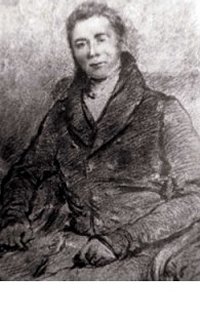 |
William TOMKYNS William Tomkyns, or Tomkins, was the son of Rev Thomas Tomkyns (c1761-1839) and Mary née Messiter (d1830, Yeovil). He was born on 6 February 1799. William qualified as a Doctor of Medicine and was a Licentiate of the Royal College of Physicians and MRCS. In 1822 he married Hannah Holland (1799-1871) of St Saviour, Southwark, Surrey. William's medical practice, and also his home, from the 1820s until his death was Magnolia House in Princes Street. Both William and his brother Edwin were involved in the Yeovil Reform Riot of 1831. |
n June 1837 William was appointed Registrar of Births and Deaths for Yeovil District comprising the parishes of Yeovil, Preston Plucknett, Lufton, Mudford, Brimpton and Thorne Coffin. He held the post until retiring in May 1855. He was a member of the committee convened to establish a railway station in Yeovil. He was also a Police Commissioner and in 1838 gave evidence in the manslaughter trial against James Beare, watch-man of Yeovil. He also served as a Churchwarden at St John's church. Rising in eminence throughout his career, he was Chairman of the Crewkerne & Yeovil Medical Association in the early 1850s and served as the Coroner for Yeovil. William Tomkyns died at Magnolia House on 8 November 1855, aged 56.
![]()
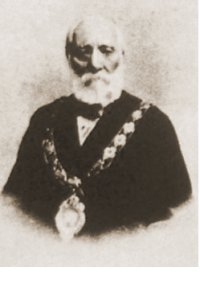 |
Henry Cary TOMPKINS Henry Cary Tompkins was born in 1824 in Castle Cary, Somerset, son of labourer John Tompkins and his wife Mary. In the 1841 census John and his family were living at Haysend (off Roping Path, close to Sparrow Road). 17-year-old Henry was listed as a glover. In the winter of 1848 Henry married Emily Hunt in Yeovil. They were to have six daughters. In 1851 Henry and Emily were listed living in South Street. Henry gave his occupation as a glove cutter while Emily gave hers as a glove sewer. |
Sadly, in the autumn of 1858 Emily died, probably in childbirth and Henry briefly moved to Stoke-sub-Hamdon, where he worked as a 'Foreman in a Glove Factory'. In the winter of 1863 Henry Cary Tomkins and his niece, Mary Jane Wheadon, were married in Yeovil. The Post Office Directory of 1875 listed him as a 'Grocer & Baker of Reckleford'.
Henry entered local politics and, certainly by the time of the 1881 census, politics was coming to the fore in his life as he listed his occupation as 'Town Councilor & Baker' rather than listing his trade first. An Alderman of the Borough, Henry was elected Mayor of Yeovil and served in 1897-98. In the winter of 1899, Henry Cary Tomkins died in Yeovil. He was aged 76.
![]()
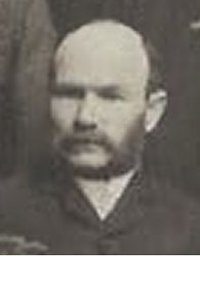 |
Henry TRASK Henry Trask was born in 1842 in Yeovil, the son of whitesmith Samuel Trask and his wife Emma née Samways. By 1861 the family were living in Kingston where 19-year-old Henry was a smith working with his father. On 16 September 1867 at Haydon, Dorset, Henry married Susannah Williams, known as Susy. Henry began his mineral water business in 1881 and by 1891 had moved to Yeovil, advertising in Whitby's Yeovil Almanack Advertiser 'Trask & Son, Mineral Water Manufacturers'. |
Trask's mineral water manufactory was located immediately next door to the gasworks and was demolished in 1894 and the site used to build the Liberal Club, erected in 1895. From this time onwards the family-run aerated water business moved to Vicarage Street, near Quidham Place, taking over the Channing bottled water works. Henry Trask died 27 February 1900 at Yeovil, at the age of 57. The aerated water business, retaining the name Trask & Son, was continued by his son John.
![]()
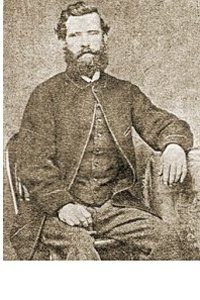 |
Frederick TREBLE Frederick Treble was born about 1832 in Paddington, London, the son of artist Benjamin Treble and his wife Eliza. In 1856, in Coventry, Warwickshire, he married widow Elizabeth Wyndham, a 'Professor of Music and Language'; they were to have seven children. In 1857 he was made bankrupt. By 1859 he was living in Yeovil working as an artist with John Swatridge. In 1861 Frederick and Elizabeth were living in Middle Street and Frederick gave his occupation as 'Artist in Painting, Practising Photography'. |
By 1867 he had moved on to Hastings where he practiced as an 'Artist Photographer'. By 1881 he had moved again, this time to 28 Camera Square (how apt), Chelsea, London. He then moved to Norwich and by 1911 he had retired.
![]()
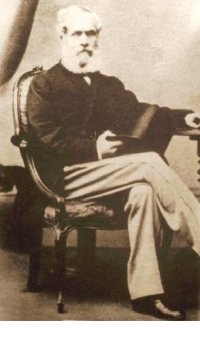 |
Robert TUCKER Robert Tucker was born in Yeovil on 31 January 1802, the son of Robert Tucker the Elder and Margaret née Messiter of Barwick. In 1827 he was married to Sarah, daughter of gentleman and banker Henry Whitmash of Whitmash & White. However Sarah died on 3 April 1831 aged just 27. They had four daughters but only one survived to adulthood. Robert Tucker became a prominent glove manufacturer and lived at Hendford Lodge. In 1821 and 1822 he was a Churchwarden of St John's church and re-elected in 1830 and 1832. He was also a member of the Vestry and one of the founders of the "Yeovil Coal and Potatoe Charity". |
He entered local politics in the 1840's and was appointed as a Town Commissioner. After 1841 he became the permanent Vice-Chairman. He lent money to the Commission on several occasions (£300 in 1849 - in excess of £300,000 at today's value) and served on the special Commission to take over markets and build the new Town Hall. He supported the campaign for municipal reform in Yeovil and although he was not on the new Borough Council formed in 1854, he was the only non-member to be elected Alderman. He served as mayor of Yeovil from 1858 until 1860. Robert Tucker died at Hendford Lodge on 27 October 1867, aged 65.
![]()
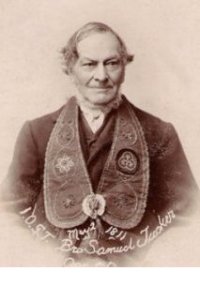 |
Samuel TUCKER Samuel Tucker was born to March 1812 at Northleigh, Devon, the youngest of the nine children of agricultural labourer James Tucker (1771-1851) and Mary née Bishop (1771-1861). On 17 December 1835, at Lyme Regis, Samuel married Ann Hocking of Axminster. They were to have nine children. By the time of the 1851 census Samuel had moved his family (now seven children) to South Street, Axminster where he gave his occupation as a whitesmith. By 1871 he had moved to Yeovil. Samuel listed his occupation as blacksmith while Mary was a dressmaker, |
Samuel became a member of the temperance movement known as the International Organisation of Good Templars (IOGT). The IOGT originated as one of a number of fraternal organizations for temperance or total abstinence founded in the nineteenth century and with a structure modeled on Freemasonry, using similar ritual and regalia as seen in the photograph of 'Brother' Samuel above, photographed in 1901 when he was aged 90. Samuel Tucker died in the spring of 1905, aged 95.
![]()
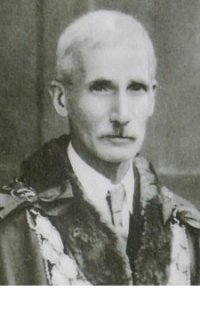 |
William Earle TUCKER William Earle Tucker was born in Yeovil in 1865, the son of entrepreneur, glove manufacturer and town developer William Tucker (1838-1899) and Frances née Vincent. His father also ran the Glovers Arms in Reckleford from at least 1871 until his death at the turn of the century. The Glovers Arms was also the family home. In the 1881 census the 16-year old William, listed as Earle (presumably the name the family knew him as?) gave his occupation as a solicitor's clerk. He would later join Newman Painter, a firm of Yeovil solicitors that later merged with Messrs Battens of Church Street. |
He was elected to the Yeovil Borough Council in November 1920, as one of the representatives for the East Ward. Nine years later he became Mayor, an office he held for three terms until 1932. He was elevated to the aldermanic bench in 1930. For twenty years William was Chairman of the Council's Improvement Committee. On 21 July 1956, William died at the age of 91.
![]()
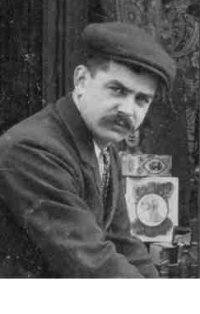 |
Frederick Thomas Wakeley Frederick Thomas Wakely, known as Fred, was born in Yeovil in 1878 and baptised on 12 June 1878 at Holy Trinity. He was son of butcher Thomas Wakely (b1846) and Eliza née Frampton (b1852). In the 1891 census, 13-year-old Fred gave his occupation as a grocer's assistant. In the 1901 census, now living with his family at 17 Vicarage Street, 23-year-old Fred gave his occupation as a cycle engineer. On 25 December 1902, at St John's church, Fred married Brenda Eliza Robbins (b1879), the daughter of Louis Robbins and Emily née Galpin. |
Fred and Brenda were to have two children, both born in Yeovil. In the b1911 census, Fred, Brenda and their two children were listed at 11 King Street. Fred gave his occupation as a cycle engineer. Fred died in Yeovil during the spring of 1954. He was 75 years old.
![]()
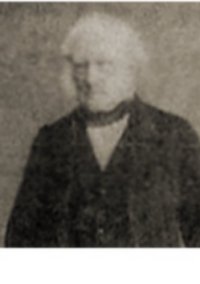 |
Alfred Bullock Baghott WATTS Alfred Bullock Baghott Watts was born in Yeovil during the winter of 1821. He was the son of Samuel Watts the younger (1774-1843) and his second wife Anna Maria Baghot (1780-1848). In the 1841 census, Alfred, at this time 15 years old, was a chemist's apprentice. His parents died in the 1840s and by 1851 he was living in rooms at 14 Drummond Crescent, St Pancras, Middlesex. He gave his occupation as 'General Practitioner in Medicine & Apothecary to the Northern Dispensary'. |
On 28 January 1852 at Taunton, he married Maria Elizabeth Lowten (1834-1926). They were to have ten children. Alfred later emigrated to New Zealand, where he practiced as a doctor. He died on 21 February 1893 at Manaia, New Zealand, aged 72.
![]()
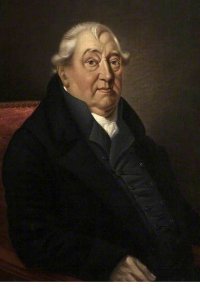 |
Samuel WATTS the Elder Samuel Watts the elder was born in Warminster, Wiltshire, in 1734. He was the son of Samuel Watts and Hester née Ingram (b1711). On 13 February 1764, he married Betty Bullock from the wealthy family of Yeovil landowners. Samuel and Betty were to have five sons.
In 1767, at the
age of 33,
Samuel Watts
took up a
five-year
clerkship with
William Stuckey,
a solicitor of
Eastover,
Langport and
connected with
the banking firm
of
Stuckey's.
At this time, of
course, the
majority of
solicitors were
also engaged in
a variety of
commercial
activities such
as banking,
insurance and
real estate. |
The banking firm of Messrs. Watts, Marsh, Bullock & Co. that became Samuel Watts & Co. was established in the lifetime of Samuel Watts the Elder, but probably too late for his active participation although Yeovil Bank was a private bank established by Yeovil attorney Samuel Watts the Elder. The bank was probably founded around 1810 and was certainly active during the early 1820s. Samuel Watts the Elder died in 1820, aged 86, and was buried at St John's on 3 February 1820.
![]()
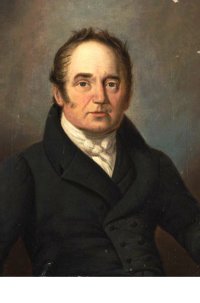 |
Samuel WATTS the Younger Samuel Watts, the younger, was born 2 April 1774 in Yeovil. He was the second son of Yeovil solicitor Samuel Watts the elder (see above) and Mary née Bullock. In 1791, when he was 17, he entered a five-year indentured clerkship with his father. His uncle, Thomas Bullock Watts, acted as Commissioner and signed the indenture. Samuel Watts the younger was to be a solicitor in Yeovil for more than thirty years, from 1796 until 1826.
He
married
Elizabeth
Marsh in
1799 at
Chew
Magna,
Somerset.
They
were to
have two
sons |
Yeovil Bank was a private bank established by Samuel's father, Samuel Watts the Elder. The bank was probably founded around 1810 and was certainly active during the early 1820s. A reference in the London Gazette in 1812 has it Watts Marsh & Co. (Samuel the younger, his brother Joseph Watts and Thomas Marsh). The Nossiter bankruptcy of 1815 has as one of his creditors Messrs Watts Marsh & Bullock & Co. Later in 1815 it was announced that this banking partnership was dissolved by mutual consent. By 1822 (Pigot's Directory) it had become Samuel Watts & Co. It would then have gone out of business on 8 November 1823, when Samuel Watts the Younger, scrivener and banker, was declared bankrupt. Samuel Watts the Younger died on 7 February 1843 aged 69.
![]()
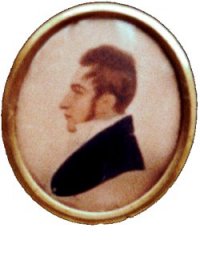 |
George Edward WELLINGTON
George
Edward Wellington was
born on 26
January 1781 in
Chard, the son
of John
Wellington
(1747-1827) and
Molly née Bowden
(1753-1830). On
26 November
1803, he married
Elizabeth
Edwards in
Yeovil. They
were to have
four children.
Both Elizabeth
and their fourth
baby, John, died
in 1815. On 22
September 1817
at Wayford, near
Chard, George
married
Elizabeth Jane
Sampson. George
was aged 36,
Elizabeth was
23. They were to
have ten
children. |
George Wellington was a chemist, druggist, grocer and wine merchant, his premises being in the Borough. The churchwardens of St John's church had an account with him for the supply of oils, paints and candles for the church and he was listed in the accounts almost annually between 1815 and 1836. He was listed as a grocer of the Borough in Pigot's Directory of 1824 and as a 'Chymist & Druggist' of the Borough in Pigot's Directory of 1830.
In public life, George was a member of Yeovil's Vestry, a burgess and served as Portreeve between 1813 and 1820. He was also the Assistant Overseer of the Poor for the parish as well as being a churchwarden in 1840 and 1841. George Wellington died on 10 November 1847, being found drowned in a pit in a field in the parish of Yeovil, called Coomb Street.
![]()
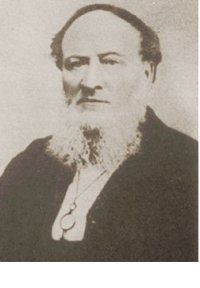 |
Elias WHITBY the Younger Elias Whitby the Younger was born in Yeovil on 19 February 1810, the son of glove manufacturer and wool dealer Elias Whitby the Elder and Hannah née Hooper. On 19 February 1833 he married Hannah Lyndall (1808-1888) the daughter of Samuel and Rebecca Lyndall. Elias and Hannah were to have eleven children. He was a glove manufacturer in partnership with his father and brother James. Their glove factory was sited where the Glovers Walk shopping precinct now stands. |
This partnership was dissolved by mutual consent in February 1849. The 1846 Tithe Apportionment noted that Elias was the owner / occupier of the large house called Ashgrove in Mudford Road, on the corner of Sparrow Lane (today's Sparrow Road). He was a Town Commissioner and argued strongly in favour of municipal reform as well as arguing for a repeal of the laws against Nonconformists. He was elected to the Borough Council in 1854 and was on the Burgess List from 1854 until his death. By 1861 he had moved his family to Kingston House, where he gave his occupation as 'retired glove manufacturer, town councillor'. He became mayor of Yeovil from 1862 to 1864 and re-elected in 1872-3. In the 1871 census, still living in Kingston, Elias gave his occupation as magistrate. Elias Whitby the Younger died in Yeovil on 16 January 1880 at the age of 69.
![]()
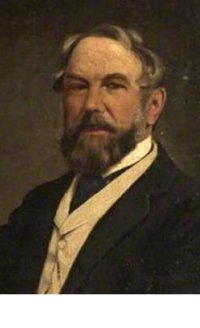 |
Elias Lyndall WHITBY Elias Lyndall Whitby was born in Middle Street, Yeovil on 17 November 1833, the oldest of the eleven children of glove manufacturer Elias Whitby Jnr (1810-1888) - see above - and Hannah née Lyndall (1808-1888). On 17 August 1858 Elias Lyndall married Caroline Edwards (b1836) at the South Street Baptist chapel. Caroline was the daughter of pawnbroker and draper of Middle Street James Edwards and his wife Mary Ann. Elias and Caroline were to have seven children. In the 1861
census Elias and
Caroline,
together with
their first two
childrenwere
listed living in
Peter Street
|
Elias gave his occupation as 'Manufacturer of Leather & Cloth Gloves, Employing 50 men, 28 boys, 21 Women and 25 Girls'. Elias' company was Whitby Brothers - although at the moment I'm not certain which of his brothers was also a partner.
Elias spent many years in local politics. He was elected to the Borough Council and was elected Mayor of Yeovil in 1878. In 1888 he was appointed as a Borough Magistrate (at which time he was living at Court Ash House) and he became a Land Tax Commissioner in 1899. He served for many years as a member of the Yeovil United Districts School Board as a member for Yeovil Borough. After the death of Caroline, Elias moved to Great Malvern, Worcestershire, and died in a nursing home there on 4 September 1911.
![]()
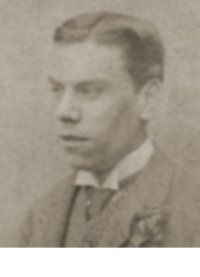 |
Alfred James WALDEN
Alfred
James
Walden
was born
on 1
January
1867 at
8 South
Street,
Lambeth,
London.
He was
later
known
professionally
as Harry
Wincott.
He was
the son
of coach
body
maker
Alfred
Walden
and
Charlotte
Susan
née
Phillips.
He had
ambitions
to be a
songwriter
and he
was
dismissed
from his
clerk's
job for
writing
songs in
the
ledgers.
When he
was
sixteen
he got
an
interview
with a
great
music
hall
artiste
of the
time
'The
Great
Vance',
who
bought
one of
his
songs
for
seven
shillings
and
sixpence
(about
£35 at
today's
value).
|
He invested some of this money in the paper he would need to start writing in earnest. He struggled for a long time until one of his songs, written under his professional name of Harry Wincott, was bought for £4 (over £400 at today's value). It was sung by the famous music hall performer Vesta Tilley in her act and Harry's songwriting career began in earnest.
On 23 March 1889, at Leeds, Harry married Eliza Mary Ann Dyer (1866-1926), the daughter of bookbinder George Turffrey Dyer (1838-1908) and Hannah Mary née Phillips (1836-1906). Harry gave his profession as 'Songwriter' and Eliza as 'Tailoress'. They were to have eight children. Harry's most prolific songwriting period was between 1890 and 1920, writing some 2,000 songs in his career. Eliza died in 1926 and on 6 March 1937 70-year old Harry married 64-year old widow Margaret Pink. Harry stated his profession as 'Author and Songwriter'. Margaret gave her profession as 'Music Hall Artiste'. Shortly after their wedding Harry and Margaret moved to Yeovil, where he died, aged 80, on 20 April 1947.
![]()
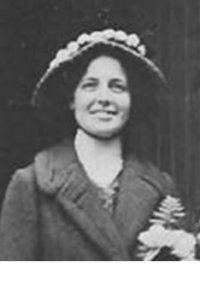 |
Marion 'Marie' WRIGHT Marion Wright, known as Marie, was born on 26 May 1885 at Bridport, Dorset. She was the seventh of the ten children of District Insurance Inspector Thomas Wright (1848-1930). Some time after 1904, the family moved to Yeovil, where by 1911 Marion was living at Heathville, The Park. While
living
in
Yeovil,
Marie
met and
fell in
love
with
Arthur
Woolcott
(1879-1961).
Arthur
emigrated
to
Cottage
Grove,
Oregon,
United
States,
in 1907,
and
Marie
travelled
to join
him in
the
United
States
where
they
would
get
married.
|
Marie set off for America, as a second class passenger, aboard the RMS Titanic on its maiden voyage. On 14 April, four days into the crossing and about 375 miles (600 km) south of Newfoundland, the Titanic hit an iceberg and eventually sank. Marie was rescued by the RMS Carpathia. In the Carpathia's Passenger List of 1912, Marie was noted as a single female, place of origin Yeovil, port of departure recorded as "Rescued from shipwrecked Titanic". The Carpathia arrived in New York, New York, on 18 April 1912.
Just five days after her horrific ordeal, Marie married Arthur Woolcott at St Christopher's Chapel in New York City, New York, USA, on 20 April 1912. Arthur and Marie were to have three sons. Arthur died on 3 November 1961 at Cottage Grove, Oregon, aged 81. Marie died at Cottage Grove on 4 July 1965, aged 80.
![]()
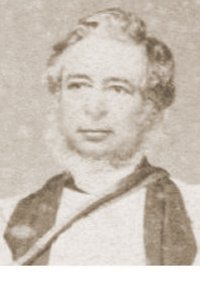 |
Reverend Edmund WYNDHAM Edmund Wyndham was born on 20 September 1835 at Bramshaw, Hampshire. He was the second of the eight children of local magistrate William Wyndham (1769-1862) and Ellen née Heathcote (1803-1883).
The 1851
census recorded
that 15-year-old
Edmund, together
with his
brothers -
14-year-old
Arthur and
11-year-old Hugh
were pupil
boarders at
Grove College,
Walcot,
Somerset. Edmund
went on to study
at Magdalen
College, Oxford,
where he
achieved his
B.A.
|
On Sunday 18 December 1864, at an ordination held by the Bishop of Bath and Wells in the Cathedral Church of Wells, Edmund was admitted into holy orders as a deacon. The following year, on 17 December 1865, again at Wells, Edmund was admitted into holy orders as a priest. He held his first curacy at Bishop's Lydeard, near Taunton, until instituted to the rectory of West Chelborough, Dorset, in December 1872.
In July 1865, at Tiverton, Devon, Edmund married Augusta Margaret Harrison (1834-1932) of Clayhanger, Devon. They did not have children. On Wednesday 1 October 1873, Edmund was inducted as the Vicar of Yeovil. He and Augusta moved into Yeovil Vicarage at 63 Hendford (today's 70 Hendford). Edmund left Yeovil on 9 November 1884, and died on 14 December 1899 at Exmouth, Devon. He was aged 64.